-
 Torii Kiyomitsu II (Kiyomine), Japanese, 1787–1868. Courtesan and her Komura (Doll Festival). Series: Furyu Goyo no Matsu (Customs of 5 Pine Needles, the 5 great festivals). Publisher: Tsuruya Kiemon [Marks: 553].
Torii Kiyomitsu II (Kiyomine), Japanese, 1787–1868. Courtesan and her Komura (Doll Festival). Series: Furyu Goyo no Matsu (Customs of 5 Pine Needles, the 5 great festivals). Publisher: Tsuruya Kiemon [Marks: 553]. -
 Utagawa Kunisada (Japanese: 歌川 国貞; also known as Utagawa Toyokuni III (三代歌川豊国); 1786 – 12 January 1865).
Utagawa Kunisada (Japanese: 歌川 国貞; also known as Utagawa Toyokuni III (三代歌川豊国); 1786 – 12 January 1865).A young woman reading a book in the light of a lamp. Series: Arigataki miyo no kage-e (Shadow Pictures of an Auspicious Age). There are five known prints, half-length portraits of beauties, in this series, designed by Kunisada in ca. 1844. Another print from the series in this collection: SVJP-0306.2020: A young woman adjusting her hairpins in the light of a paper lantern.
Signed: Kōchōrō Toyokuni ga (香蝶楼豊国画).
Publisher: Maruya Kiyojiro.
Size: Vertical Ōban (37.5 x 25.4 cm). -
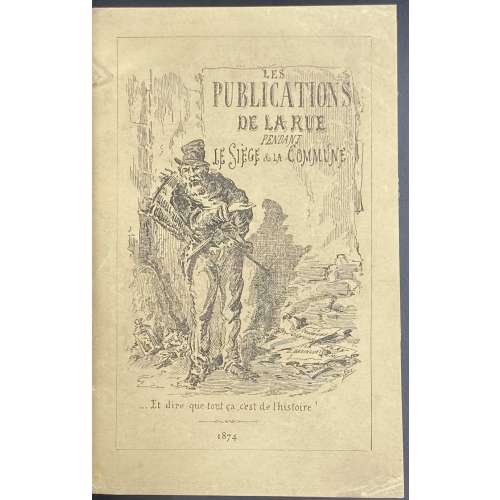 Convolute with three editions, dedicated to the Commune of Paris, 1871. (1) LES | Publications de la Rue | pendant | LE SIEGE ET LA COMMUNE | SATIRES — CANARDS — COMPLAINTES — CHANSONS | PLACARDS ET PAMPHLETS | BIBLIOGRAPHIE | PITTORESQUE ET ANECDOTIQUE | Par Firmin MAILLARD |{publisher’s device}| PARIS | AUGUSTE AUBRY, ÉDITEUR | 18, RUE SÉGUIER, 18 | 1874 || Pagination: ffl, original pictorial wrapper, [2] – blank / advert., [2] – h.t. / blank, [2] – h.t. / colophon imprim. PILLET FILS AINÉ, frontis. similar to front wrapper without '1874', [2] – t.p. / blank, [v] vi-xii, [1] 2-198, three blank leaves, back wrapper. (2) VILLE DE SAINT-DENIS | EXPOSITION D'ART & D'HISTOIRE | La Commune de Paris |18 Mars 1871 28 Mai | AVANT-PROPOS DE Lucien DESCAVES | de l’Académie Goncourt | PREFACE DE Jacques DORIOT | Député de la Seine, Maire de Saint-Denis | Du 17 Mars au 26 Mai 1935 | au Musée Municipal | 4, place de la Légion d’Honneur – Saint-Denis || Pagination: original pictorial wrapper in black and red, frontis., [2] - t.p. / blank, [2] – commité, v-xiii [xiv] 1-113 [114], 26 plates (13 leaves), blank back wrapper, spine tipped-in. (3) J. LEMONNYER | LES | JOURNAUX DE PARIS | PENDANT | LA COMMUNE | REVUE BIBLIOGRAPHIQUE COMPLETE | DE LA PRESSE PARISIENNE | du 19 Mars au 27 Mai | AVEC |{7 lines of text}| ET | UNE TABLE ALPHABÉTIQUE | DONNANT LE PRIX-COURANT DE CHAQUE COLLECTION | PARIS : J. LEMONNYER, Librarire | 73, Rue de Provence, 73 || Pagination: [2] - t.p. / blank, [2] – preface, [7] 8-94, green back wrapper w/advert., bfl. (lacks original front wrapper). Binding: Modern (20th century) red cloth, black label with gilt lettering to spine, matching marbled endpapers. Size: 18.5 x 13 cm; 12mo.
Convolute with three editions, dedicated to the Commune of Paris, 1871. (1) LES | Publications de la Rue | pendant | LE SIEGE ET LA COMMUNE | SATIRES — CANARDS — COMPLAINTES — CHANSONS | PLACARDS ET PAMPHLETS | BIBLIOGRAPHIE | PITTORESQUE ET ANECDOTIQUE | Par Firmin MAILLARD |{publisher’s device}| PARIS | AUGUSTE AUBRY, ÉDITEUR | 18, RUE SÉGUIER, 18 | 1874 || Pagination: ffl, original pictorial wrapper, [2] – blank / advert., [2] – h.t. / blank, [2] – h.t. / colophon imprim. PILLET FILS AINÉ, frontis. similar to front wrapper without '1874', [2] – t.p. / blank, [v] vi-xii, [1] 2-198, three blank leaves, back wrapper. (2) VILLE DE SAINT-DENIS | EXPOSITION D'ART & D'HISTOIRE | La Commune de Paris |18 Mars 1871 28 Mai | AVANT-PROPOS DE Lucien DESCAVES | de l’Académie Goncourt | PREFACE DE Jacques DORIOT | Député de la Seine, Maire de Saint-Denis | Du 17 Mars au 26 Mai 1935 | au Musée Municipal | 4, place de la Légion d’Honneur – Saint-Denis || Pagination: original pictorial wrapper in black and red, frontis., [2] - t.p. / blank, [2] – commité, v-xiii [xiv] 1-113 [114], 26 plates (13 leaves), blank back wrapper, spine tipped-in. (3) J. LEMONNYER | LES | JOURNAUX DE PARIS | PENDANT | LA COMMUNE | REVUE BIBLIOGRAPHIQUE COMPLETE | DE LA PRESSE PARISIENNE | du 19 Mars au 27 Mai | AVEC |{7 lines of text}| ET | UNE TABLE ALPHABÉTIQUE | DONNANT LE PRIX-COURANT DE CHAQUE COLLECTION | PARIS : J. LEMONNYER, Librarire | 73, Rue de Provence, 73 || Pagination: [2] - t.p. / blank, [2] – preface, [7] 8-94, green back wrapper w/advert., bfl. (lacks original front wrapper). Binding: Modern (20th century) red cloth, black label with gilt lettering to spine, matching marbled endpapers. Size: 18.5 x 13 cm; 12mo. -
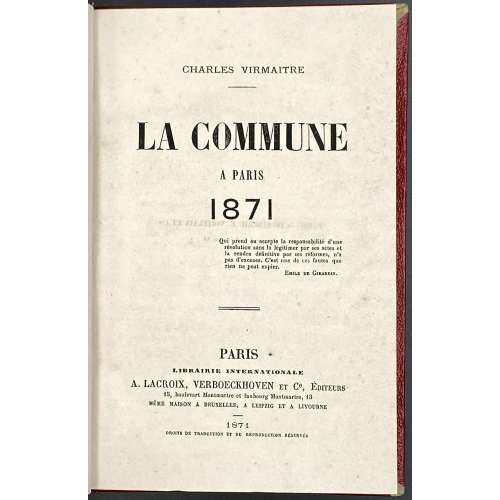 Title : CHARLES VIRMAITRE | LA COMMUNE | A PARIS | 1871 | {cit. 5 lines Emile de Girardin} | PARIS | LIBRAIRIE INTERNATIONALE | A. LACROIX, VERBOECKHOVEN ET Ce, ÉDITEURS | 15 boulevart Montmartre et faubourg Montmartre, 13 | MÉME MAISON A BRUXELLES, A LEIPZIG ET A LIVOURNE | 1871 | DROITS DE TRADUCTION ET DE REPRODUCTION RÉSERVÉS || Pagination : [2] – h.t. / imprint., [2] – t.p. / blank, [2] – dedicatation to Thiers / blank, [2] – table / blank, [1], 2-280; [total 288 pages]. Collation: 18mo; π4 1-1318 1514. Binding: red quarter morocco over red buckram boards, raised bands, gilt lettering, gilt flower lozenges in compartments, marbled endpapers.
Title : CHARLES VIRMAITRE | LA COMMUNE | A PARIS | 1871 | {cit. 5 lines Emile de Girardin} | PARIS | LIBRAIRIE INTERNATIONALE | A. LACROIX, VERBOECKHOVEN ET Ce, ÉDITEURS | 15 boulevart Montmartre et faubourg Montmartre, 13 | MÉME MAISON A BRUXELLES, A LEIPZIG ET A LIVOURNE | 1871 | DROITS DE TRADUCTION ET DE REPRODUCTION RÉSERVÉS || Pagination : [2] – h.t. / imprint., [2] – t.p. / blank, [2] – dedicatation to Thiers / blank, [2] – table / blank, [1], 2-280; [total 288 pages]. Collation: 18mo; π4 1-1318 1514. Binding: red quarter morocco over red buckram boards, raised bands, gilt lettering, gilt flower lozenges in compartments, marbled endpapers. -
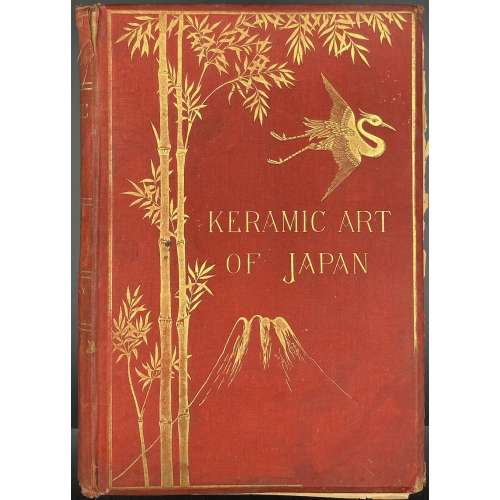 Title-page (in red and black): Keramic art of Japan, | BY | GEORGE A. AUDSLEY | AND | JAMES L. BOWES. | LONDON: HENRY SOTHERAN & CO., | 36 PICADILLY; 136, STRAND; 77 & 78, QUEEN STREET, CITY. | MANCHESTER: 49, CROSS STREET. | MDCCCLXXXI. || Description: 28.5 x 19.5 cm, publisher’s red cloth, bevelled boards, gilt lettering and tooling on front cover and spine, AEG, disbound. 304 p., 10 pl., 32 chromo-lithographed plates. This is the 2nd edition of the 1875 folio edition by the same publisher.. Contents: Introductory essay on Japanese art: p. 1-107; Keramic art of Japan: p. 108-260; Marks and monograms: p. 261-287, Index: p. 288-304. Contributors: George Ashdown Audsley (American, 1838 – 1925) – author. James Lord Bowes (British, 1834 – 1899) – author.
Title-page (in red and black): Keramic art of Japan, | BY | GEORGE A. AUDSLEY | AND | JAMES L. BOWES. | LONDON: HENRY SOTHERAN & CO., | 36 PICADILLY; 136, STRAND; 77 & 78, QUEEN STREET, CITY. | MANCHESTER: 49, CROSS STREET. | MDCCCLXXXI. || Description: 28.5 x 19.5 cm, publisher’s red cloth, bevelled boards, gilt lettering and tooling on front cover and spine, AEG, disbound. 304 p., 10 pl., 32 chromo-lithographed plates. This is the 2nd edition of the 1875 folio edition by the same publisher.. Contents: Introductory essay on Japanese art: p. 1-107; Keramic art of Japan: p. 108-260; Marks and monograms: p. 261-287, Index: p. 288-304. Contributors: George Ashdown Audsley (American, 1838 – 1925) – author. James Lord Bowes (British, 1834 – 1899) – author. -
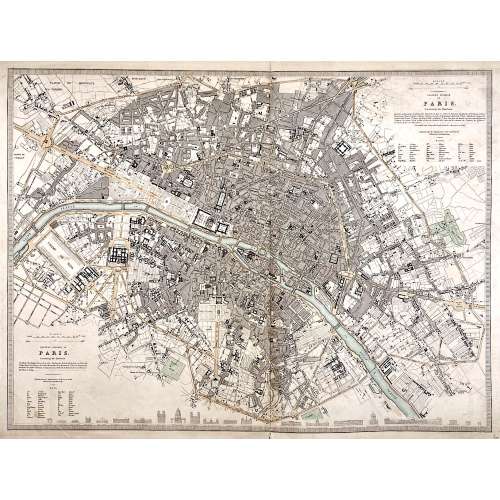 Top right: EASTERN DIVISION OF | PARIS. | Containing the Quartiers | {5 lines in italic} | Published under the Superintendence of the Society for the | Diffusion of Useful Knowledge || Bottom left: WESTERN DIVISION OF | PARIS. | Containing the Quartiers | {4 lines in italic} | Published under the Superintendence of the Society for the | Diffusion of Useful Knowledge || The map is framed, but there is no lettering beneath the frame to identify the cartographer, engraver, and publisher. However, we can attribute it to William Barnard Clarke (British, 1806 – 1865) and John Shury (fl. c. 1814-1844). The publisher is either Baldwin & Cradock or Chapman and Hall. Dimensions: Sheet: 40 x 60.8 cm; Image: 40 x 53.5 cm.
Top right: EASTERN DIVISION OF | PARIS. | Containing the Quartiers | {5 lines in italic} | Published under the Superintendence of the Society for the | Diffusion of Useful Knowledge || Bottom left: WESTERN DIVISION OF | PARIS. | Containing the Quartiers | {4 lines in italic} | Published under the Superintendence of the Society for the | Diffusion of Useful Knowledge || The map is framed, but there is no lettering beneath the frame to identify the cartographer, engraver, and publisher. However, we can attribute it to William Barnard Clarke (British, 1806 – 1865) and John Shury (fl. c. 1814-1844). The publisher is either Baldwin & Cradock or Chapman and Hall. Dimensions: Sheet: 40 x 60.8 cm; Image: 40 x 53.5 cm. -
 Bandō Mitsugorō III as Daihanji Kiyozumi and Arashi Koroku IV as Koganosuke in kabuki play Imoseyama, an example of womanly virtue (Imoseyama onna teikin). 大判事清澄 坂東三津五郎」(三代)・「久我之助 嵐小六」(四代) Artist: Shunkōsai Hokushū [春好斎北洲] (Japanese, fl. 1802 – 1832) Year: 1821 (3rd month). MFA description: “The Kabuki play Mount Imo and Mount Se: An Exemplary Tale of Womanly Virtue (Imoseyama onna teikin), originally based on a puppet play, is set in ancient Japan when the Soga clan served as regents to the emperor. Two children, Hinadori and Koganosuke, of rival court families, are held hostage under orders from the tyrant Soga no Iruka to ensure their families do not revolt. The children fall in love, but rather than create conflicts for their families they each vow to die by suicide. When the parents learn of their plans, they resolve to cooperate to overthrow Iruka. Here Koganosuke and his father Kiyozumi are shown; a companion sheet on the left would have shown Hinadori and her mother Sadaka.” The play Imoseyama, an example of womanly virtue (Imoseyama onna teikin), was staged at Osaka's Kado Shibai (Kadoza, Kado Gekijô, Kado no Shibai) from 3/1821. According to Herwig, it is the right sheet of a diptych (see below). MFA Accession number: 2011.128 Kabuki actors: Bandō Mitsugorō III [三代目 坂東 三津五郎] (Japanese, 1775 – 1831); other names: Bandō Minosuke I, Morita Kanjirô II, Bandō Mitahachi I, Bandō Minosuke I, Bandō Mitahachi I. Arashi Koroku IV [四代目嵐小六] (Japanese, 1783 – 1826)
Bandō Mitsugorō III as Daihanji Kiyozumi and Arashi Koroku IV as Koganosuke in kabuki play Imoseyama, an example of womanly virtue (Imoseyama onna teikin). 大判事清澄 坂東三津五郎」(三代)・「久我之助 嵐小六」(四代) Artist: Shunkōsai Hokushū [春好斎北洲] (Japanese, fl. 1802 – 1832) Year: 1821 (3rd month). MFA description: “The Kabuki play Mount Imo and Mount Se: An Exemplary Tale of Womanly Virtue (Imoseyama onna teikin), originally based on a puppet play, is set in ancient Japan when the Soga clan served as regents to the emperor. Two children, Hinadori and Koganosuke, of rival court families, are held hostage under orders from the tyrant Soga no Iruka to ensure their families do not revolt. The children fall in love, but rather than create conflicts for their families they each vow to die by suicide. When the parents learn of their plans, they resolve to cooperate to overthrow Iruka. Here Koganosuke and his father Kiyozumi are shown; a companion sheet on the left would have shown Hinadori and her mother Sadaka.” The play Imoseyama, an example of womanly virtue (Imoseyama onna teikin), was staged at Osaka's Kado Shibai (Kadoza, Kado Gekijô, Kado no Shibai) from 3/1821. According to Herwig, it is the right sheet of a diptych (see below). MFA Accession number: 2011.128 Kabuki actors: Bandō Mitsugorō III [三代目 坂東 三津五郎] (Japanese, 1775 – 1831); other names: Bandō Minosuke I, Morita Kanjirô II, Bandō Mitahachi I, Bandō Minosuke I, Bandō Mitahachi I. Arashi Koroku IV [四代目嵐小六] (Japanese, 1783 – 1826)
Ref.: [LIB-1197.2016] Arendie and Henk Herwig. Heroes of the kabuki stage: an introduction to kabuki with retellings of famous plays, illustrated by woodblock prints. — Amsterdam: Hotei Publishing, 2004; p. 72:
Ref: [LIB-2973.2022] Ukiyo-e: A journey through the Floating World / Exhibition catalogue (Japan, Jan-Jul 2014). — The Yomiuri Shimbun, 2014; № 358, p. 226. "Bandō Mitsugorō III as Grand arbiter Kiyosumi and Arashi Koroku IV as Koganosuke":
-
 Artist: Toyohara Chikanobu [豊原周延] (Japanese, 1838 – 1912) Signed: Chikanobu hitsu [周延筆] Publisher: [ 東京掘江町] Tokyo Horiemachi | [えん市製] Enshi-sei. Media: Fan print (uchiwa-e, 団扇絵), 192 x 172 mm. Possibly Iwai Kumesaburō IV [岩井粂三郎] (1856 – 1886) a.k.a. Iwai Hisajirō III [岩井久次郎] in the role of Ono no Komachi [小野乃小町] and Nakamura Shikan IV [中村芝翫] in the role of Kisen Hōshi [喜せん法師]. Play: The Six Immortal Poets in Colorful Guises [六歌仙体綵] (Rokkasen Sugata no irodori). Inscription: Left: Kisen [喜せん] | Shikan [芝翫] Right: Komachi [小町] | Kumesaburō [粂三郎]. Actors: Iwai Kumesaburō IV [岩井粂三郎] (1856 – 1886) a.k.a. Iwai Hisajirō III [岩井久次郎]. Nakamura Shikan IV [中村芝翫] (Japanese, 1831 – 1899); other names: Nakamura Fukusuke I [中村福助], Nakamura Masanosuke I, Nakamura Komasaburō, Nakamura Tamatarō I.
Artist: Toyohara Chikanobu [豊原周延] (Japanese, 1838 – 1912) Signed: Chikanobu hitsu [周延筆] Publisher: [ 東京掘江町] Tokyo Horiemachi | [えん市製] Enshi-sei. Media: Fan print (uchiwa-e, 団扇絵), 192 x 172 mm. Possibly Iwai Kumesaburō IV [岩井粂三郎] (1856 – 1886) a.k.a. Iwai Hisajirō III [岩井久次郎] in the role of Ono no Komachi [小野乃小町] and Nakamura Shikan IV [中村芝翫] in the role of Kisen Hōshi [喜せん法師]. Play: The Six Immortal Poets in Colorful Guises [六歌仙体綵] (Rokkasen Sugata no irodori). Inscription: Left: Kisen [喜せん] | Shikan [芝翫] Right: Komachi [小町] | Kumesaburō [粂三郎]. Actors: Iwai Kumesaburō IV [岩井粂三郎] (1856 – 1886) a.k.a. Iwai Hisajirō III [岩井久次郎]. Nakamura Shikan IV [中村芝翫] (Japanese, 1831 – 1899); other names: Nakamura Fukusuke I [中村福助], Nakamura Masanosuke I, Nakamura Komasaburō, Nakamura Tamatarō I. -
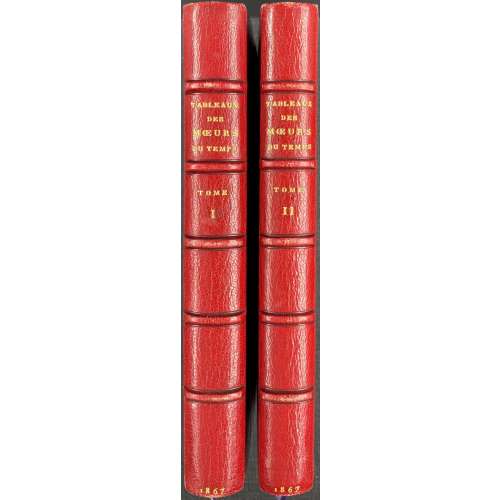 Two volumes in-12, 16.8 x 11.5 cm each, uniformly bound in ¾ red crushed morocco over marbled boards, spine with raised bands and gilt lettering, marbled endpapers, text printed on laid paper, 6 plates (3 in each vol.) on India paper pasted in on thick laid paper leaves. This edition seems similar to Nordmann I 203 but without Félicien Rops' frontispiece and plates, replaced by unsigned etchings attributed to Gustave Staal. Title-page (red and black): LE RICHE DE LA POPELINIÈRE | – | TABLEAUX | DES | MŒURS DU TEMPS | DANS LES DIFFÉRENTS AGES DE LA VIE | – | NOTICE DE | CHARLES MONSELET | – | TOME PREMIER (SECOND) | {fleuron} | PARIS | IMPRIMERIE DES CI-DEVANT FERMIERS GÉNÉRAUX | – | M D CCC L XVII || Vol. 1: π2 (h.t., t.p.) a4 (Notice), 1-1312 151 (Table); total 91 leaves plus three leaves of plates. Pagination: [4] [i] ii-vii [viii] [3] 4-168 [2]; total 182 pp, ils. facing pp. 59, 78, and 94. Vol. 2: π2 (h.t., t.p.), 1-1312, 152; total 88 leaves plus three leaves of plates. Pagination: [4] [1] 2-170 [2]; total 176 pp, ils. facing pp. 74, 78, and 145. Catalogue raisonné: Dutel I: A-1044 — without Félicien Rops ‘ornementations’, but with ‘6 gravures de 1865’. Dutel suggests that the edition was performed by A. Poulet-Malassis, Briard or Lécrivain. Catalogue Poulet-Malassis & ses amis description: № 43. LE RICHE DE LA POPELINIÈRE. Tableaux des mœurs du temps dans les diérents âges de la vie, tome premier (— second). Notice de M. Charles Monselet. Imprimerie des ci-devant fermiers généraux, Paris, M D CCC LXVII [A. Poulet-Malassis, 1867]. Exemplaire sans le frontispice de Félicien Rops mais bien complet des 6 figures de Staal, justification qui illustre les aléas de la confection des publications clandestines. D’une part, c’est une autre édition qui est décrite par Launay. L’exemplaire vendu chez Maître Loudmer avait 6 figures, comme ici. Cluzel a vu un “front. et 4 vignettes de Rops plus cinq figures libres (par Staal)”, Simonson a vu 5 figures de Rops, etc., etc. Il y a 3 bandeaux et 3 culs-de-lampe de Rops qui ont été fréquemment utilisés par d’autres éditeurs pour d’autres titres pendant toute la seconde moitié du xixe siècle. La Léonina présente une fiche détaillée sur 4 pages. 3 bandeaux et 3 culs-de-lampe gravés sur bois de Rops. Bibliographie : Pia 1389, Launay 327, Gay 6-308, Pey 122 (1800 frs avec 5 figures), PC 503 et 504, Lemonnyer 3-1173, LL 66, Leonina 81, Nordmann 1-203, Dutel A-1043. Contributors: Alexandre Jean Joseph Le Riche de La Popelinière (French, 1693 – 1762) – author. Charles Monselet (French, 1825 – 1888) – author (foreword). Pierre-Gustave-Eugène Staal (French, 1817 – 1882) – artist. Auguste Poulet-Malassis (French, 1825 – 1878) – publisher.
Two volumes in-12, 16.8 x 11.5 cm each, uniformly bound in ¾ red crushed morocco over marbled boards, spine with raised bands and gilt lettering, marbled endpapers, text printed on laid paper, 6 plates (3 in each vol.) on India paper pasted in on thick laid paper leaves. This edition seems similar to Nordmann I 203 but without Félicien Rops' frontispiece and plates, replaced by unsigned etchings attributed to Gustave Staal. Title-page (red and black): LE RICHE DE LA POPELINIÈRE | – | TABLEAUX | DES | MŒURS DU TEMPS | DANS LES DIFFÉRENTS AGES DE LA VIE | – | NOTICE DE | CHARLES MONSELET | – | TOME PREMIER (SECOND) | {fleuron} | PARIS | IMPRIMERIE DES CI-DEVANT FERMIERS GÉNÉRAUX | – | M D CCC L XVII || Vol. 1: π2 (h.t., t.p.) a4 (Notice), 1-1312 151 (Table); total 91 leaves plus three leaves of plates. Pagination: [4] [i] ii-vii [viii] [3] 4-168 [2]; total 182 pp, ils. facing pp. 59, 78, and 94. Vol. 2: π2 (h.t., t.p.), 1-1312, 152; total 88 leaves plus three leaves of plates. Pagination: [4] [1] 2-170 [2]; total 176 pp, ils. facing pp. 74, 78, and 145. Catalogue raisonné: Dutel I: A-1044 — without Félicien Rops ‘ornementations’, but with ‘6 gravures de 1865’. Dutel suggests that the edition was performed by A. Poulet-Malassis, Briard or Lécrivain. Catalogue Poulet-Malassis & ses amis description: № 43. LE RICHE DE LA POPELINIÈRE. Tableaux des mœurs du temps dans les diérents âges de la vie, tome premier (— second). Notice de M. Charles Monselet. Imprimerie des ci-devant fermiers généraux, Paris, M D CCC LXVII [A. Poulet-Malassis, 1867]. Exemplaire sans le frontispice de Félicien Rops mais bien complet des 6 figures de Staal, justification qui illustre les aléas de la confection des publications clandestines. D’une part, c’est une autre édition qui est décrite par Launay. L’exemplaire vendu chez Maître Loudmer avait 6 figures, comme ici. Cluzel a vu un “front. et 4 vignettes de Rops plus cinq figures libres (par Staal)”, Simonson a vu 5 figures de Rops, etc., etc. Il y a 3 bandeaux et 3 culs-de-lampe de Rops qui ont été fréquemment utilisés par d’autres éditeurs pour d’autres titres pendant toute la seconde moitié du xixe siècle. La Léonina présente une fiche détaillée sur 4 pages. 3 bandeaux et 3 culs-de-lampe gravés sur bois de Rops. Bibliographie : Pia 1389, Launay 327, Gay 6-308, Pey 122 (1800 frs avec 5 figures), PC 503 et 504, Lemonnyer 3-1173, LL 66, Leonina 81, Nordmann 1-203, Dutel A-1043. Contributors: Alexandre Jean Joseph Le Riche de La Popelinière (French, 1693 – 1762) – author. Charles Monselet (French, 1825 – 1888) – author (foreword). Pierre-Gustave-Eugène Staal (French, 1817 – 1882) – artist. Auguste Poulet-Malassis (French, 1825 – 1878) – publisher. -
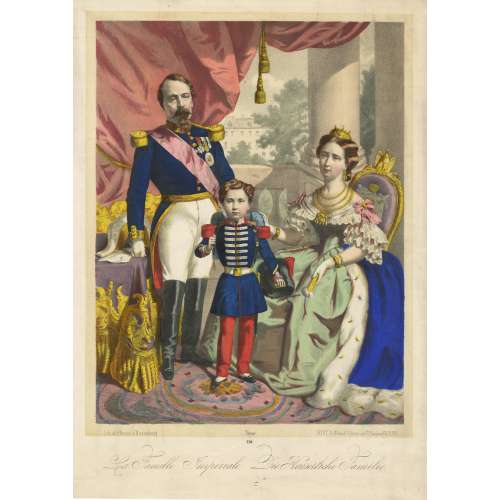 Hand-coloured lithography on wove paper, 395 x 280 mm; black ink stamp “5309” to reverse. On image: artist's initials "L. H."; on stone: "Lith. de Fr. Wentzel a Wissembourg. — Déposé — DÉPÔT, Fr. Wentzel Editeur rue St. Jacques 65, PARIS"; below centre: "239"; bottom : La famille Impériale. Die Kaizerliche Familie. Napoleon III [Charles-Louis Napoléon Bonaparte] (French, 1808 – 1873) Eugénie de Montijo [L'impératrice Eugénie] (Spanish-French, 1826 – 1920) Napoléon, Prince Imperial (Napoléon Eugène Louis Jean Joseph Bonaparte] (French, 1856 – 1879) Jean Frédéric Wentzel (French, 1807 – 1869) – publisher/printer.
Hand-coloured lithography on wove paper, 395 x 280 mm; black ink stamp “5309” to reverse. On image: artist's initials "L. H."; on stone: "Lith. de Fr. Wentzel a Wissembourg. — Déposé — DÉPÔT, Fr. Wentzel Editeur rue St. Jacques 65, PARIS"; below centre: "239"; bottom : La famille Impériale. Die Kaizerliche Familie. Napoleon III [Charles-Louis Napoléon Bonaparte] (French, 1808 – 1873) Eugénie de Montijo [L'impératrice Eugénie] (Spanish-French, 1826 – 1920) Napoléon, Prince Imperial (Napoléon Eugène Louis Jean Joseph Bonaparte] (French, 1856 – 1879) Jean Frédéric Wentzel (French, 1807 – 1869) – publisher/printer. -

Жуковский Ю. Г. Политические и общественные теории XVI-го века. - С.Петербург, 1866. Типография А. Головачева. // Материалы для общественной науки. - 163 с.
Схоластика.
Макиавелли и Томас Мор.
Реформация: Лютер, Кальвин, анабаптисты.
Жан Боден.
[Штамп на титуле: A. Namoradze, Tiflis. 1935.]
-
 Artist: Utagawa Kunisada [歌川 国貞] a.k.a. Utagawa Toyokuni III [三代歌川豊国] (Japanese, 1786 – 1865). Block cutter: Horikō (Kiyomizu) Ryūzō [彫工 柳三]. Publisher: Ebisuya Shoshichi [恵比寿屋庄七], Kinshōdō (Japanese, fl. c. 1846 – 1883). Actor Morita Kan'ya XI as Saito Tarozaemon Toshiyuki (Morito Kan'ya, Saito Tarozaemon Toshiyuki) Signed Toyokuni ga within the artist's Toshidama cartouche, publisher's seal Sho, Kinshodo, carver's seal Horiko Ryusan, censor's seal aratame with date 1860, 3rd month. Date: 3/1860. Oban tate-e; 36.5 x 25.3 cm. The actor Morita Kan'ya XI (1802-1863) is in the role of Saito Tarozaemon Toshiyuki from the play Oto no Miya Asahi no Yoroi (Oto no Miyo and the Armor of the Rising Sun). The play picks up following the Genko War of 1331-33 in which Emperor Go-Daigo (1288-1339) led a failed uprising against the ruling Hojo clan. Tarozaemon was a Hojo warlord and is credited with much of the victory. After the conflict, his lord Norisada receives a summer festival lantern from the courtesan Sanmi-no-Tsubone, which bears a riddling inscription. He and Tarozaemon deliberate over the courtesan and her message for quite some time until they realize that she is attempting to manipulate Norisada in the hopes of returning the Emperor from exile. Following this revelation, Norisada reinterprets the message to mean kiriko, literally "to cut a child," and determines that Sanmi-no-Tsubone's son must be killed. He instructs Tarozaemon to do the deed. However, unbeknownst to Norisada and in spite of his allegiance to the Hojo clan, Tarozaemon is sympathetic to Sanmi-no-Tsubone and her son. At one time, his own daughter had served in the Imperial Palace and was spared execution only through Sanmi-no-Tsubone's intervention. As repayment of that debt, he kills his own grandson in the other boy's stead and returns to Norisada to report that he had accomplished the mission. This print is from a series of portraits that Kunisada undertook very late in life and has been named Kinshodo-ban yakusha okubi-e (Kinshodo's Large-Head Actor Portraits) in reference to the publisher, Ebisuya Shochochi of Kinshodo. The series depicted great actors from the past and present in their famous roles. Kunisada was guided by images from his own oeuvre: he recorded Kan'ya in this role in the 8th month of 1829. As this was meant to be Kunisada's grandest actor series, it was executed on thick paper with the best possible pigments and the highest level of craftsmanship. In this unusual frontal portrait, Kunisada presents Morita Kan'ya XI as the loyal Tarozaemon with his eyes rolling upward and his jaw set in grim determination to commit the unthinkable act in an ultimate display of samurai honour. Text by Scholten Japanese Art, New York. Ref.: Waseda University Theatre Museum (enpaku.waseda.ac.jp), accession no. 100-5261 (for 1829 portrait of the same); [LIB-1212.2017] Robert Schaap. Kunisada: Imaging, drama and beauty. — Leiden: Hotei Publishing, 2016, p. 165 (№ 16). Andreas Marks. Publishers of Japanese woodblock prints: A compendium. Ebisuya Shoshichi (1846-83) - P6032.
Artist: Utagawa Kunisada [歌川 国貞] a.k.a. Utagawa Toyokuni III [三代歌川豊国] (Japanese, 1786 – 1865). Block cutter: Horikō (Kiyomizu) Ryūzō [彫工 柳三]. Publisher: Ebisuya Shoshichi [恵比寿屋庄七], Kinshōdō (Japanese, fl. c. 1846 – 1883). Actor Morita Kan'ya XI as Saito Tarozaemon Toshiyuki (Morito Kan'ya, Saito Tarozaemon Toshiyuki) Signed Toyokuni ga within the artist's Toshidama cartouche, publisher's seal Sho, Kinshodo, carver's seal Horiko Ryusan, censor's seal aratame with date 1860, 3rd month. Date: 3/1860. Oban tate-e; 36.5 x 25.3 cm. The actor Morita Kan'ya XI (1802-1863) is in the role of Saito Tarozaemon Toshiyuki from the play Oto no Miya Asahi no Yoroi (Oto no Miyo and the Armor of the Rising Sun). The play picks up following the Genko War of 1331-33 in which Emperor Go-Daigo (1288-1339) led a failed uprising against the ruling Hojo clan. Tarozaemon was a Hojo warlord and is credited with much of the victory. After the conflict, his lord Norisada receives a summer festival lantern from the courtesan Sanmi-no-Tsubone, which bears a riddling inscription. He and Tarozaemon deliberate over the courtesan and her message for quite some time until they realize that she is attempting to manipulate Norisada in the hopes of returning the Emperor from exile. Following this revelation, Norisada reinterprets the message to mean kiriko, literally "to cut a child," and determines that Sanmi-no-Tsubone's son must be killed. He instructs Tarozaemon to do the deed. However, unbeknownst to Norisada and in spite of his allegiance to the Hojo clan, Tarozaemon is sympathetic to Sanmi-no-Tsubone and her son. At one time, his own daughter had served in the Imperial Palace and was spared execution only through Sanmi-no-Tsubone's intervention. As repayment of that debt, he kills his own grandson in the other boy's stead and returns to Norisada to report that he had accomplished the mission. This print is from a series of portraits that Kunisada undertook very late in life and has been named Kinshodo-ban yakusha okubi-e (Kinshodo's Large-Head Actor Portraits) in reference to the publisher, Ebisuya Shochochi of Kinshodo. The series depicted great actors from the past and present in their famous roles. Kunisada was guided by images from his own oeuvre: he recorded Kan'ya in this role in the 8th month of 1829. As this was meant to be Kunisada's grandest actor series, it was executed on thick paper with the best possible pigments and the highest level of craftsmanship. In this unusual frontal portrait, Kunisada presents Morita Kan'ya XI as the loyal Tarozaemon with his eyes rolling upward and his jaw set in grim determination to commit the unthinkable act in an ultimate display of samurai honour. Text by Scholten Japanese Art, New York. Ref.: Waseda University Theatre Museum (enpaku.waseda.ac.jp), accession no. 100-5261 (for 1829 portrait of the same); [LIB-1212.2017] Robert Schaap. Kunisada: Imaging, drama and beauty. — Leiden: Hotei Publishing, 2016, p. 165 (№ 16). Andreas Marks. Publishers of Japanese woodblock prints: A compendium. Ebisuya Shoshichi (1846-83) - P6032. -
 Woman Looking out a Round Window at a Woman with a Komusō Hat.
Woman Looking out a Round Window at a Woman with a Komusō Hat.Artist Koikawa Harumasa (a.k.a. Banki): fl. 1801–18. Wikipedia: Koikawa Harumasa (恋川 春政; active 1800–1820), later called Banki Harumasa (晩器 春政). Associated with Katsukawa school.
Signed: Banki ga (on the bamboo flower container in the background). Censor's seal: kiwame. Mark of unidentified publisher, Genshoku #1017; Marks U084 Ibiko, p. 387.
References:
Jacob Pins #828.
-
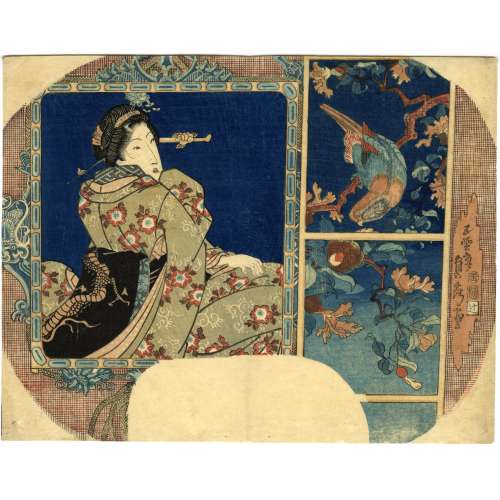 Artist: Utagawa Sadahide [歌川 貞秀], a.k.a. Gountei Sadahide [五雲亭 貞秀] (1807 – c. 1878/9). Publisher: Iseya Ichiemon [伊勢屋市右衛門] (Japanese, fl. c 1823 – 1864), seal name Kaku-Tsuji [角辻]. Signed: Gountei Sadahide ga [五雲亭貞秀画] Censor's seal: kiwame, date seal: Tenpō 3 (1832). Size: Uncut fan print (uchiwa-e); 218 x 282 mm. Portrait of a young woman dressed in a green kimono decorated with arabesque (karakusa) and flowers, her black obi adorned with a dragon, in a western-style frame, on a blue background; and a painting of a parrot on a pomegranate tree. A similar design was used by Sadahide in 1860, described in detail by Sebastian Izzard in his Japanese Prints of the Mid-Nineteenth Century: 1830–1865, September 20–October 24, 2006 exhibition: Picture of a Curio Shop in Yokohama: reverse painting on glass of a crimson parrot, coloured copperplate engraving of a mother and child (Yokohama urimono mise no zu: gyokuban abura-e, doban-e saishiki). Colour woodblock print: oban tate-e, 143/8 x 93/4 in. (36.5 x 24.8 cm.); Man-en I/3 (3/1860) Series: Picture of Goods for Sale in Yokohama (Yokohama urimono zue no uchi) Signature: Gountei Sadahide ga, double toshidama seal Publisher: Daikokuya Kinnosuke.
Artist: Utagawa Sadahide [歌川 貞秀], a.k.a. Gountei Sadahide [五雲亭 貞秀] (1807 – c. 1878/9). Publisher: Iseya Ichiemon [伊勢屋市右衛門] (Japanese, fl. c 1823 – 1864), seal name Kaku-Tsuji [角辻]. Signed: Gountei Sadahide ga [五雲亭貞秀画] Censor's seal: kiwame, date seal: Tenpō 3 (1832). Size: Uncut fan print (uchiwa-e); 218 x 282 mm. Portrait of a young woman dressed in a green kimono decorated with arabesque (karakusa) and flowers, her black obi adorned with a dragon, in a western-style frame, on a blue background; and a painting of a parrot on a pomegranate tree. A similar design was used by Sadahide in 1860, described in detail by Sebastian Izzard in his Japanese Prints of the Mid-Nineteenth Century: 1830–1865, September 20–October 24, 2006 exhibition: Picture of a Curio Shop in Yokohama: reverse painting on glass of a crimson parrot, coloured copperplate engraving of a mother and child (Yokohama urimono mise no zu: gyokuban abura-e, doban-e saishiki). Colour woodblock print: oban tate-e, 143/8 x 93/4 in. (36.5 x 24.8 cm.); Man-en I/3 (3/1860) Series: Picture of Goods for Sale in Yokohama (Yokohama urimono zue no uchi) Signature: Gountei Sadahide ga, double toshidama seal Publisher: Daikokuya Kinnosuke.
-
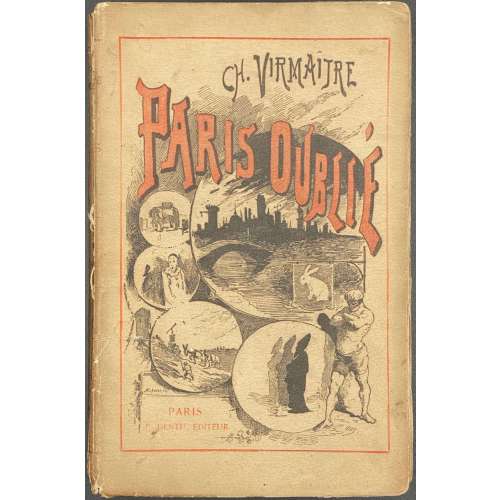 Cover: CH. VIRMAÎTRE | PARIS OUBLIÉ — PARIS | E. DENTU, ÉDITEUR || Title page: CHARLES VIRMAÎTRE | PARIS OUBLIÉ | {publisher’s device} | PARIS | E. DENTU, ÉDITEUR | LIBRAIRE DE LA SOCIÉTÉ DES GENTES DE LETTRES | PALAIS-ROYAL, 15-17-19, GALERIE D’ORLÉANS | 1886 | Tous droits réservés. || Pagination: publisher’s pictorial wrapper, ffl, [2] – t.p. / blank, 1-327 [328 blank], bfl, publisher’s advert. to back wrapper.
Cover: CH. VIRMAÎTRE | PARIS OUBLIÉ — PARIS | E. DENTU, ÉDITEUR || Title page: CHARLES VIRMAÎTRE | PARIS OUBLIÉ | {publisher’s device} | PARIS | E. DENTU, ÉDITEUR | LIBRAIRE DE LA SOCIÉTÉ DES GENTES DE LETTRES | PALAIS-ROYAL, 15-17-19, GALERIE D’ORLÉANS | 1886 | Tous droits réservés. || Pagination: publisher’s pictorial wrapper, ffl, [2] – t.p. / blank, 1-327 [328 blank], bfl, publisher’s advert. to back wrapper. -
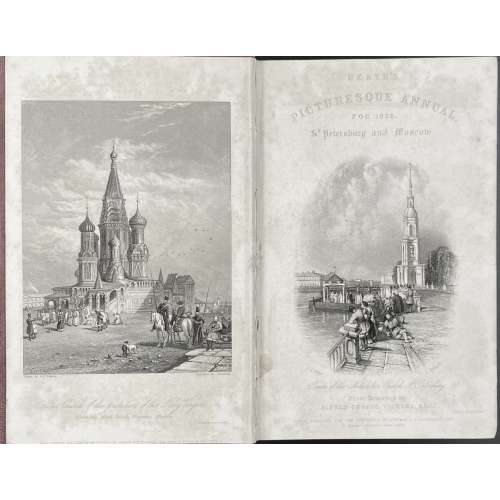 Engraved title: HEATH'S | PICTURESQUE ANNUAL, | FOR 1836. | St. Petersburg and Moscow. | {vignette Nikolskoi church signed: A.G. Vickers — E. Radclyffe} | Tower of the Nikolskoi church St. Petersburg | From Drawings by | ALFRED GEORGE VICKERS, ESQ. | Printed by Arnold & Fisher | LONDON, PUBLISHED FOR THE PROPRIETOR, BY LONGMAN & Co. PATERNOSTER ROW: | RITTNER & Co. PARIS: & ASHER, BERLIN. || Title page: A JOURNEY | TO ST. PETERSBURG AND MOSCOW | THROUGH COURLAND AND LIVONIA. | BY | LEITCH RITCHIE, Esq. | AUTHOR OF “TURNER’S ANNUAL TOUR”, “SCHINDERHANNES,” &c. | WITH TWENTY-FIVE SPLENDID ENGRAVINGS, | BY THE FIRST ARTISTS, AFTER DRAWINGS, | BY A.G. VICKERS, Esq. | LONDON: | LONGMAN, REES, BROWN, GREEN, AND LONGMAN. | PARIS: RITTNER AND GOUPILL. BERLIN: A. ASHER. | 1836. || Imprint: LONDON: | PRINTED BY J. HADDON AND CO., DOCTORS’ COMMONS. Pagination: [i-iii] iv [4] [1] 2-256, total 264 pages + 25 plates. Collation: 12mo; π4, B-Y6 Z2; total 132 leaves + frontispiece, engraved title and 23 leaves of steel-engraved plates w/tissue guards, extraneous to collation. Binding: full red morocco, blind-stamped boards, gilt-lettered spine, all edges gilt, 12mo, 20 x 13 cm. Note: Schinderhannes – real name Johannes Bückler (German, c.1778 – 1803): Leitch Ritchie. Schinderhannes: the Robber of the Rhine. (Library of Romance). — London: Smith, Elder, and Co., 1833. Contributors:
Engraved title: HEATH'S | PICTURESQUE ANNUAL, | FOR 1836. | St. Petersburg and Moscow. | {vignette Nikolskoi church signed: A.G. Vickers — E. Radclyffe} | Tower of the Nikolskoi church St. Petersburg | From Drawings by | ALFRED GEORGE VICKERS, ESQ. | Printed by Arnold & Fisher | LONDON, PUBLISHED FOR THE PROPRIETOR, BY LONGMAN & Co. PATERNOSTER ROW: | RITTNER & Co. PARIS: & ASHER, BERLIN. || Title page: A JOURNEY | TO ST. PETERSBURG AND MOSCOW | THROUGH COURLAND AND LIVONIA. | BY | LEITCH RITCHIE, Esq. | AUTHOR OF “TURNER’S ANNUAL TOUR”, “SCHINDERHANNES,” &c. | WITH TWENTY-FIVE SPLENDID ENGRAVINGS, | BY THE FIRST ARTISTS, AFTER DRAWINGS, | BY A.G. VICKERS, Esq. | LONDON: | LONGMAN, REES, BROWN, GREEN, AND LONGMAN. | PARIS: RITTNER AND GOUPILL. BERLIN: A. ASHER. | 1836. || Imprint: LONDON: | PRINTED BY J. HADDON AND CO., DOCTORS’ COMMONS. Pagination: [i-iii] iv [4] [1] 2-256, total 264 pages + 25 plates. Collation: 12mo; π4, B-Y6 Z2; total 132 leaves + frontispiece, engraved title and 23 leaves of steel-engraved plates w/tissue guards, extraneous to collation. Binding: full red morocco, blind-stamped boards, gilt-lettered spine, all edges gilt, 12mo, 20 x 13 cm. Note: Schinderhannes – real name Johannes Bückler (German, c.1778 – 1803): Leitch Ritchie. Schinderhannes: the Robber of the Rhine. (Library of Romance). — London: Smith, Elder, and Co., 1833. Contributors:Author: Leitch Ritchie (British, 1800 – 1865).
Illustrator: Alfred Gomersal Vickers (British, 1810 – 1837).
Publisher: Longman, Rees, Orme, Brown, Green and Longman (London).
Engravers: Turnbull, Thomas (British, fl. 1830s); Radclyffe, Edward (British, 1810 – 1863); Jorden, Henry (British, fl. 1829 – 1838); Fisher, Samuel (British, 1806 – 1851); Willmore, James Tibbits (British, 1800 – 1863); Higham, Thomas (British, 1795 – 1844); Appleton, J. W. (British, fl. 1834 – 1843); Wallis, Robert William (British, 1794 – 1878); Chevalier, William (British, 1804 – 1866); Kernot, James Harfield (British, 1802 – 1858); Lewis, James (British, 1782 – 1858); Carter, James (British, 1798 – 1855). Printer: John Haddon & Co. (London). Reference: Metropolitan Museum (NY); Royal Collection Trust (London). -
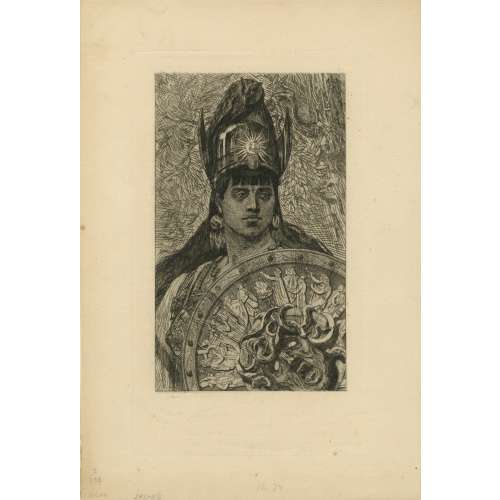
Etching and drypoint on wove paper, depicting Athena with an awl on her helmet and holding a shield with Medusa head. Owner's stamp 'LvM' on verso.
Dimensions: Paper: 38.7 x 26.5 cm; Plate: 31 x 18 cm; Image: 24.5 x 14.5 cm.
Catalogue raisonné: Arthur Hubschmid (1977): 317; Graphics irreverent and erotic (1968): 41.
-
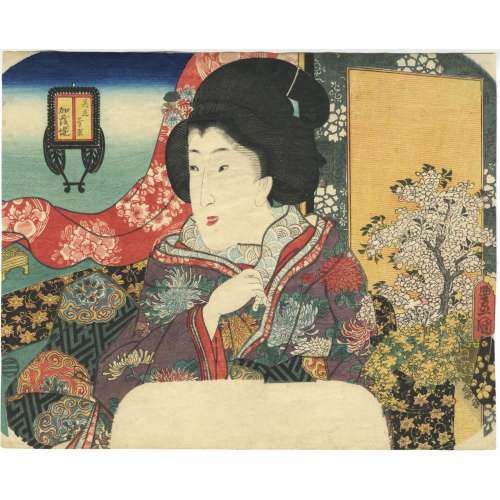 Title: On the Banks of the Kamo River [加茂堤] (Kamo Tsutsumi), sometimes transcribed as Kamo Zutsumi. Series: A Parody of Sugawara [美立菅原] (Mitate Sugawara). The word mitate is usually written as 見立 but here it is 美立, like on another Kunisada's fan print A beauty reading a book on a balcony overlooking a bay: A Parody of Sugawara Stripes (see SVJP-0334.2021 in this collection). On the Banks of the Kamo River is a scene from the play Sugawara's Secrets of Calligraphy [菅原伝授手習鑑] (Sugawara Denju Tenarai Kagami); it was originally written for the puppet theatre (Bunraku) and staged for the first time in the 8th lunar month of 1746 in Ôsaka at the Takemotoza. It was adapted for Kabuki the following month and staged for the first time in Kyôto at the Kitagawa no Shibai, produced by Nakamura Kiyosaburô I. It was also performed for the first time in Edo, at the Ichimuraza, in the 3rd lunar month of 1747. The shape of the cartouche resembles an ox cart viewed from the back which alludes to the scene Fighting for the Carriage (Kuruma biki). Artist: Utagawa Kunisada [歌川 国貞] a.k.a. Utagawa Toyokuni III [三代 歌川 豊国] (Japanese, 1786 – 1865). Signed: Toyokuni [豊国] in a red toshidama cartouche. The character ga [画] is missing (cut out). Publisher’s seal: Ibaya Senzaburō [伊場屋仙三郎] (Japanese, fl. 1815 – 1869). The date seal and censor seals were possibly trimmed out. According to [LIB-3008.2022] Andreas Marks (Tuttle, 2010; p. 267), the series was produced by Ibaya in 1851. Ref.: (1) Samuel L. Leiter. Historical dictionary of Japanese traditional theatre (Historical dictionaries of literature and the arts) / 2nd edition. – Lanham: Rowman & Littlefield, 2014©. (2) Andreas Marks. Japanese woodblock prints: Artists, publishers and masterworks, 1680 – 1900 / Foreword by Stephen Addiss. — Tuttle Publishing, 2010©. Acknowledgements: This masterpiece of ukiyo-e would not be properly described without input from Elena Varshavsky and Horst Graebner.
Title: On the Banks of the Kamo River [加茂堤] (Kamo Tsutsumi), sometimes transcribed as Kamo Zutsumi. Series: A Parody of Sugawara [美立菅原] (Mitate Sugawara). The word mitate is usually written as 見立 but here it is 美立, like on another Kunisada's fan print A beauty reading a book on a balcony overlooking a bay: A Parody of Sugawara Stripes (see SVJP-0334.2021 in this collection). On the Banks of the Kamo River is a scene from the play Sugawara's Secrets of Calligraphy [菅原伝授手習鑑] (Sugawara Denju Tenarai Kagami); it was originally written for the puppet theatre (Bunraku) and staged for the first time in the 8th lunar month of 1746 in Ôsaka at the Takemotoza. It was adapted for Kabuki the following month and staged for the first time in Kyôto at the Kitagawa no Shibai, produced by Nakamura Kiyosaburô I. It was also performed for the first time in Edo, at the Ichimuraza, in the 3rd lunar month of 1747. The shape of the cartouche resembles an ox cart viewed from the back which alludes to the scene Fighting for the Carriage (Kuruma biki). Artist: Utagawa Kunisada [歌川 国貞] a.k.a. Utagawa Toyokuni III [三代 歌川 豊国] (Japanese, 1786 – 1865). Signed: Toyokuni [豊国] in a red toshidama cartouche. The character ga [画] is missing (cut out). Publisher’s seal: Ibaya Senzaburō [伊場屋仙三郎] (Japanese, fl. 1815 – 1869). The date seal and censor seals were possibly trimmed out. According to [LIB-3008.2022] Andreas Marks (Tuttle, 2010; p. 267), the series was produced by Ibaya in 1851. Ref.: (1) Samuel L. Leiter. Historical dictionary of Japanese traditional theatre (Historical dictionaries of literature and the arts) / 2nd edition. – Lanham: Rowman & Littlefield, 2014©. (2) Andreas Marks. Japanese woodblock prints: Artists, publishers and masterworks, 1680 – 1900 / Foreword by Stephen Addiss. — Tuttle Publishing, 2010©. Acknowledgements: This masterpiece of ukiyo-e would not be properly described without input from Elena Varshavsky and Horst Graebner. -
 Artist: Utagawa Kunisada [歌川 国貞] a.k.a. Utagawa Toyokuni III [三代歌川豊国] (Japanese, 1786 – 1865). Signed: Ōju Toyokuni ga [応需豊国画], in a toshidama cartouche. Double nanushi censor seals Mera & Murata (1846-50). Publisher: Kojimaya Jūbei [小嶋屋重兵衛] (Japanese, fl. c. 1797 – 1869). Kabuki actor Ichikawa Danjūrō VIII [市川団十郎] (Ichikawa Ebizō VI, Ichikawa Shinnosuke II, Japanese, 1823 – 1854) watches the sunrise over Mount Fuji. The complete set of series Moon, Sun, Stars [月日星] (tsuki-hi-hoshi/boshi), three sources of light (sankō) [三光]:
Artist: Utagawa Kunisada [歌川 国貞] a.k.a. Utagawa Toyokuni III [三代歌川豊国] (Japanese, 1786 – 1865). Signed: Ōju Toyokuni ga [応需豊国画], in a toshidama cartouche. Double nanushi censor seals Mera & Murata (1846-50). Publisher: Kojimaya Jūbei [小嶋屋重兵衛] (Japanese, fl. c. 1797 – 1869). Kabuki actor Ichikawa Danjūrō VIII [市川団十郎] (Ichikawa Ebizō VI, Ichikawa Shinnosuke II, Japanese, 1823 – 1854) watches the sunrise over Mount Fuji. The complete set of series Moon, Sun, Stars [月日星] (tsuki-hi-hoshi/boshi), three sources of light (sankō) [三光]: -
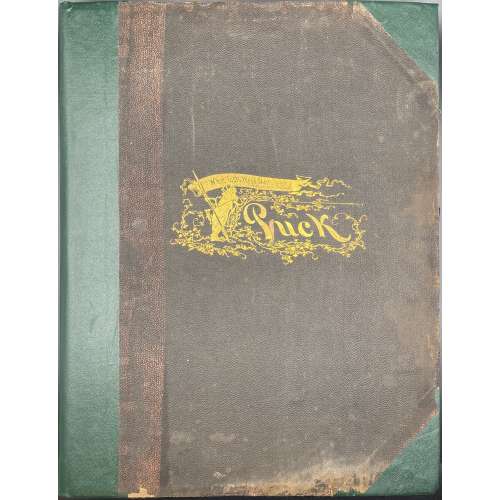 26 issues of American political humourous magazine published by Joseph Keppler (Austrian-American, 1838 – 1894) and Adolph Schwarzmann (German-American, 1838 – 1904) with caricatures by Frederick Burr Opper (American, 1857 – 1937); 35 x 27 cm, bound in faux shagreen with half green buckram backing, gilt vignette and lettering to front board: ‘What fools these Mortals be!” | MIDSUMMER NIGHT'S DREAM | PUCK ||
26 issues of American political humourous magazine published by Joseph Keppler (Austrian-American, 1838 – 1894) and Adolph Schwarzmann (German-American, 1838 – 1904) with caricatures by Frederick Burr Opper (American, 1857 – 1937); 35 x 27 cm, bound in faux shagreen with half green buckram backing, gilt vignette and lettering to front board: ‘What fools these Mortals be!” | MIDSUMMER NIGHT'S DREAM | PUCK || -
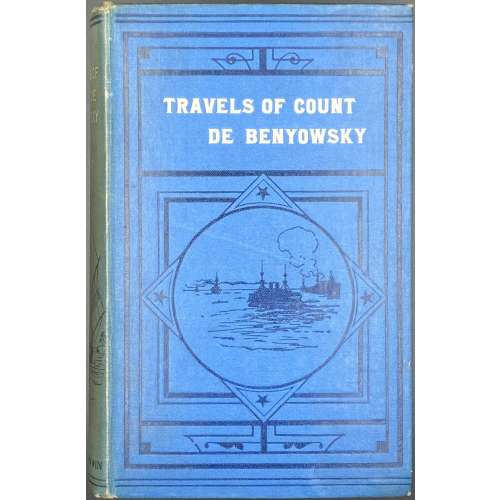 Hardcover volume in 8vo, 20.4 x 13.7 cm, blue cloth with black pictorial stamping and white embossed lettering to front cover and spine, spine sunned, head and tail frayed. Title-page: ❦❦❦ THE MEMOIRS AND | TRAVELS OF MAURITIUS | AUGUSTUS COUNT DE | BENYOWSKY ❦❦❦ | IN SIBERIA, KAMCHATKA, JAPAN, | THE LIUKIU ISLANDS AND FORMOSA | FROM THE TRANSLATION OF HIS | ORIGINAL MANUSCRIPT (1741–1771), | BY WILLIAM NICHOLSON, F.R.S., 1790 | EDITED BY CAPTAIN | PASFIELD OLIVER | ILLUSTRATED | LONDON: T. FISHER UNWIN, | PATERNOSTER SQUARE. MDCCCXCVIII || Collation/Pagination: [1]7 2-258; blue advertisement sheet laid in. [1, 2] – serial h.t. "The Adventure Series" / advert. THE ADVENTURE SERIES. Illustrated. Popular Re-issue, large cr. 8vo, 3s. 6d. 8 titles, [3, 4] – t.p. / blank, [5] 6-9 contents, [10] blank, [11, 12] missing, [13] 14-52 introduction, 53-399, [400] colophon: THE GRESHAM PRESS, | URWIN BROTHERS, | WORKING IN LONDON. Total number of leaves 199; 398 pages; one leaf of the first gathering missing (pp. 11/12 list of illustrations. No illustrations in this volume. Compared to another copy of the same edition, LIB-2701.2021, besides the binding: no list of illustrations, no illustrations, different colophon, different advertisement, slightly different h.t. Contributors: Publisher: T. Fisher Unwin (London); Thomas Fisher Unwin (British, 1848 – 1935). Author: Maurice Auguste count de Benyowsky [Мориц Август Бенёвский] (Polish-Slovak-Hungarian, 1746 –1786). Editor: Samuel Pasfield Oliver (British, 1838 – 1907). Translator: William Nicholson (British, 1753 – 1815). Originally published in 1790, in London (I have not seen it anywhere) and in Dublin by P. Wogan [etc.], and in 1791 in French, in Paris by Buisson; see LIB-2742.2021. For the 1904 edition, see LIB-2703.2021.
Hardcover volume in 8vo, 20.4 x 13.7 cm, blue cloth with black pictorial stamping and white embossed lettering to front cover and spine, spine sunned, head and tail frayed. Title-page: ❦❦❦ THE MEMOIRS AND | TRAVELS OF MAURITIUS | AUGUSTUS COUNT DE | BENYOWSKY ❦❦❦ | IN SIBERIA, KAMCHATKA, JAPAN, | THE LIUKIU ISLANDS AND FORMOSA | FROM THE TRANSLATION OF HIS | ORIGINAL MANUSCRIPT (1741–1771), | BY WILLIAM NICHOLSON, F.R.S., 1790 | EDITED BY CAPTAIN | PASFIELD OLIVER | ILLUSTRATED | LONDON: T. FISHER UNWIN, | PATERNOSTER SQUARE. MDCCCXCVIII || Collation/Pagination: [1]7 2-258; blue advertisement sheet laid in. [1, 2] – serial h.t. "The Adventure Series" / advert. THE ADVENTURE SERIES. Illustrated. Popular Re-issue, large cr. 8vo, 3s. 6d. 8 titles, [3, 4] – t.p. / blank, [5] 6-9 contents, [10] blank, [11, 12] missing, [13] 14-52 introduction, 53-399, [400] colophon: THE GRESHAM PRESS, | URWIN BROTHERS, | WORKING IN LONDON. Total number of leaves 199; 398 pages; one leaf of the first gathering missing (pp. 11/12 list of illustrations. No illustrations in this volume. Compared to another copy of the same edition, LIB-2701.2021, besides the binding: no list of illustrations, no illustrations, different colophon, different advertisement, slightly different h.t. Contributors: Publisher: T. Fisher Unwin (London); Thomas Fisher Unwin (British, 1848 – 1935). Author: Maurice Auguste count de Benyowsky [Мориц Август Бенёвский] (Polish-Slovak-Hungarian, 1746 –1786). Editor: Samuel Pasfield Oliver (British, 1838 – 1907). Translator: William Nicholson (British, 1753 – 1815). Originally published in 1790, in London (I have not seen it anywhere) and in Dublin by P. Wogan [etc.], and in 1791 in French, in Paris by Buisson; see LIB-2742.2021. For the 1904 edition, see LIB-2703.2021. -
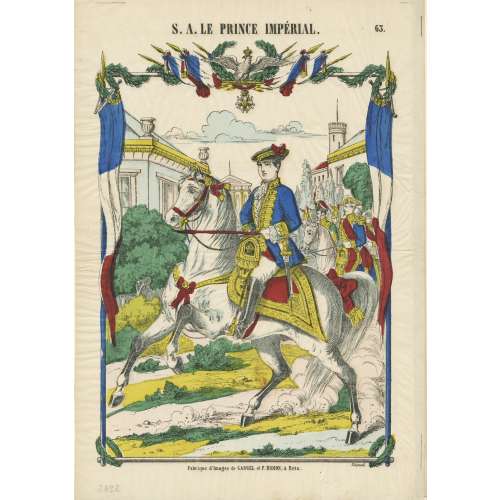 Hand-coloured woodcut on wove paper, 327 x 280 mm; black ink stamp “5265” to reverse, attached to the sheet 470 x 325 mm. Top centre: "S. A. LE PRINCE IMPÉRIAL.", right: "63." Image: equestiral portrait of Prince Impérial. Under the image, centre: "Fabrique d'Images de GANGEL et P. DIDION, à Metz." — "Déposé." Napoléon, Prince Imperial (Napoléon Eugène Louis Jean Joseph Bonaparte] (French, 1856 – 1879). Gangel et P. Didion (Metz); Paulin Didion (French, 1831 – 1879) – publisher/printer.
Hand-coloured woodcut on wove paper, 327 x 280 mm; black ink stamp “5265” to reverse, attached to the sheet 470 x 325 mm. Top centre: "S. A. LE PRINCE IMPÉRIAL.", right: "63." Image: equestiral portrait of Prince Impérial. Under the image, centre: "Fabrique d'Images de GANGEL et P. DIDION, à Metz." — "Déposé." Napoléon, Prince Imperial (Napoléon Eugène Louis Jean Joseph Bonaparte] (French, 1856 – 1879). Gangel et P. Didion (Metz); Paulin Didion (French, 1831 – 1879) – publisher/printer. -
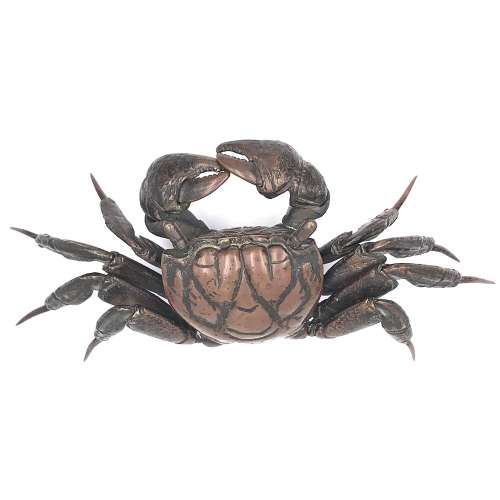 Jizai okimono bronze articulated model of a crab. Japan, Meiji period(1868-1912). Size: Body: 6.5 x 6 cm. Total: 23 x 11 cm. Weight: 762 g
Jizai okimono bronze articulated model of a crab. Japan, Meiji period(1868-1912). Size: Body: 6.5 x 6 cm. Total: 23 x 11 cm. Weight: 762 g -
 Kitagawa Utamaro. Illustration from the book Ehon koi no Onamaki. Cited at Hayashi Yoshikazu's 20-volume set Edo makura-e shi shusei: Kitagawa Utamaro. Size: Chuban (25.5 x 18.5 cm), two book pages glued together.
Kitagawa Utamaro. Illustration from the book Ehon koi no Onamaki. Cited at Hayashi Yoshikazu's 20-volume set Edo makura-e shi shusei: Kitagawa Utamaro. Size: Chuban (25.5 x 18.5 cm), two book pages glued together. -
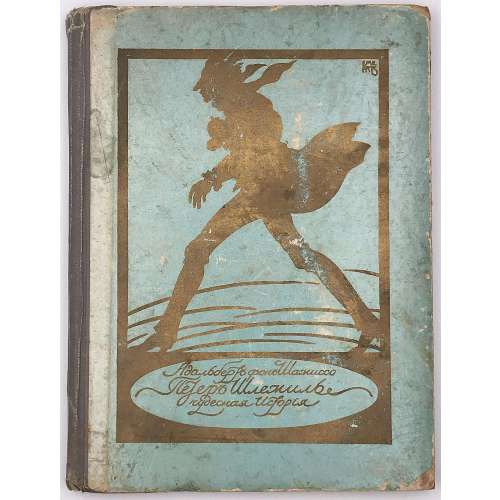
Шамиссо, Адальбертъ фонъ. Петеръ Шлемиль. Чудесная исторiя. Пер. П.Потемкина. Рис., виньетки и перепет Эмиля Преторiуса по 1-му нѣм. изд. 1814 г. — СПб.: Книгоиздательство "Пантеонъ", 1910. — 107 стр. Отпечатано в типографии акц. о-ва типографск. дела в СПБ (Герольд), 7 рота, 26.
Cardboard binding, 8vo, 20 x 15 cm. Russian translation of Adelbert von Chamisso book Peter Schlemihl, from the German by Peter Potemkine. With illustrations from 1814 original German first edition by Emil Preetorius. [SV: the latest statement seems strange as Emil Preetorius lived from 1883 to 1973]. -
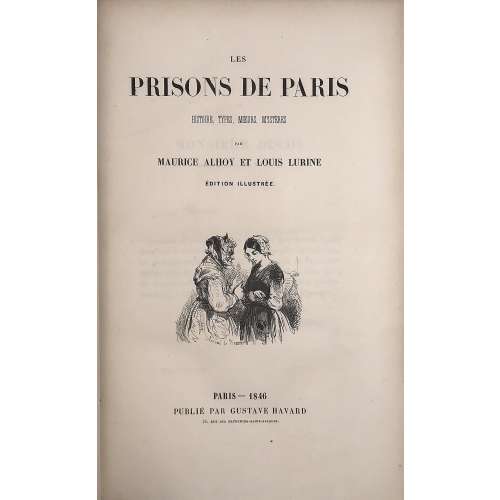 Exterior: 4to, 27.3 x 18 cm, quarter black morocco over marbled boards, double gilt fillet border, spine with raised bands, compartments framed in gilt with gilt fleurons, black label lettered in gilt; marbled endpapers. Inscription to half-title in the bottom: no 411. Bookplate to front pastedown. Title-page: LES | PRISONS DE PARIS | HISTOIRE, TYPES, MŒURS, MYSTÈRES | PAR | MAURICE ALHOY ET LOUIS LURINE | ÉDITION ILLUSTRÉE. | {vignette} | PARIS — 1846 | PUBLIÉ PAR GUSTAVE HAVARD | 24, RUE DES MATHURINS-SAINT-JACQUES. || Printer: Lacrampe et Comp. Collation: 4to; π2 a4 1-684 χ2; total 280 leaves and 34 leaves of plates. Pagination: first and last leaves blank; [2 -h.t./imprint.] [2 - t.p./blank] [2 dedication/blank] [i intro] ii-vi, [1] 2-544 [2 - list of plates/advert.] [2 - contents/blank]; total 560 pages, plus 34 wood-engraved plates, incl. a frontispiece by Laisne after Bertall, and numerous in-text woodcuts. Provenance: Bookplate of Selim Hippolyte Ansart (French, 1829 – 1897), commissar of police in the Second Empire and shortly after (chef de la police municipaie ; chevalier du 13 août 1867; vingt-trois ans de service effectif). Authors: Philadelphe-Maurice Alhoy (French, 1802 – 1856) Louis Lurine (French, 1812 – 1860) Artists: Bertall [ Bertal; Charles Albert d’Arnoux (French, 1820 – 1882) Jules [Jean-Baptiste] David (French, 1808–1892) Charles-François Pinot (French, 1817 – 1879) Eustache Lorsay [French, Eugène Lampsonius] (1822 – 1871) Pierre Édouard Frère (French, 1819 – 1886) Charles-Édouard de Beaumont (French, 1819 – 1888) Engravers Laisné Adèle / Aglaé / Alfred (French, fl. 1835 – 1868) Louis Dujardin (French, 1808 – 1859) François Rouget (Belgian, c. 1825 – ?) Janet-Lange [Ange-Louis Janet] (French, 1815 – 1872) Jacques Adrien Lavieille (French, 1818 – 1862) Timms (French, fl. c. 1839 – 1865) Félix Leblanc (French, 1823 – ?) Émile Montigneul (French, fl. 1840 – 1850)
Exterior: 4to, 27.3 x 18 cm, quarter black morocco over marbled boards, double gilt fillet border, spine with raised bands, compartments framed in gilt with gilt fleurons, black label lettered in gilt; marbled endpapers. Inscription to half-title in the bottom: no 411. Bookplate to front pastedown. Title-page: LES | PRISONS DE PARIS | HISTOIRE, TYPES, MŒURS, MYSTÈRES | PAR | MAURICE ALHOY ET LOUIS LURINE | ÉDITION ILLUSTRÉE. | {vignette} | PARIS — 1846 | PUBLIÉ PAR GUSTAVE HAVARD | 24, RUE DES MATHURINS-SAINT-JACQUES. || Printer: Lacrampe et Comp. Collation: 4to; π2 a4 1-684 χ2; total 280 leaves and 34 leaves of plates. Pagination: first and last leaves blank; [2 -h.t./imprint.] [2 - t.p./blank] [2 dedication/blank] [i intro] ii-vi, [1] 2-544 [2 - list of plates/advert.] [2 - contents/blank]; total 560 pages, plus 34 wood-engraved plates, incl. a frontispiece by Laisne after Bertall, and numerous in-text woodcuts. Provenance: Bookplate of Selim Hippolyte Ansart (French, 1829 – 1897), commissar of police in the Second Empire and shortly after (chef de la police municipaie ; chevalier du 13 août 1867; vingt-trois ans de service effectif). Authors: Philadelphe-Maurice Alhoy (French, 1802 – 1856) Louis Lurine (French, 1812 – 1860) Artists: Bertall [ Bertal; Charles Albert d’Arnoux (French, 1820 – 1882) Jules [Jean-Baptiste] David (French, 1808–1892) Charles-François Pinot (French, 1817 – 1879) Eustache Lorsay [French, Eugène Lampsonius] (1822 – 1871) Pierre Édouard Frère (French, 1819 – 1886) Charles-Édouard de Beaumont (French, 1819 – 1888) Engravers Laisné Adèle / Aglaé / Alfred (French, fl. 1835 – 1868) Louis Dujardin (French, 1808 – 1859) François Rouget (Belgian, c. 1825 – ?) Janet-Lange [Ange-Louis Janet] (French, 1815 – 1872) Jacques Adrien Lavieille (French, 1818 – 1862) Timms (French, fl. c. 1839 – 1865) Félix Leblanc (French, 1823 – ?) Émile Montigneul (French, fl. 1840 – 1850) -
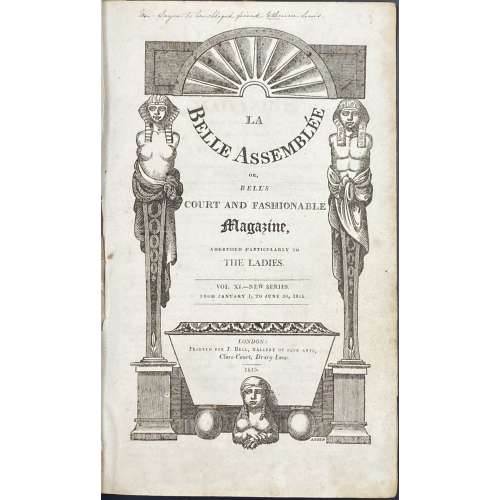 Title: LA | BELLE ASSEMBLÉE | OR, | BELL'S | COURT AND FASHIONABLE | MAGAZINE, | ADDRESSED PARTICULARLY TO | THE LADIES. | VOL. XI.—NEW SERIES. | FROM JANUARY 1, TO JUNE 30, 1815. | LONDON: | Printed for J. BELL, GALLERY OF FINE ARTS, | Clare-Court, Drury-Lane. | 1815. || Pagination: [2] – 11th volume wood-engraved pictorial title page, [1, 2] – January faux-title and table of content, [3] 4-284 [2] – index to 11th vol. Notes: February f.t. not paginated, but within the collation; the last page of the index at the very end paginated [iii]/iv, so pages i/ii missing (the gathering Nn lacking one sheet) Collation: 4to; π1 A-Mm4 Nn3, 28 plates extraneous to collation (lacking 2 plates). Binding: Half brown morocco over marbled boards, flat spine, compartments gilt-ruled with double-fillet and gilt-lettered. Contents: Jan: pp. 1-48, 5 plates. Feb: pp. 51-96, 5 plates. Mar: pp. 97-144, 5 plates. Apr: pp. 145-192, 5 plates. May: pp. 193-240, 5 plates. Jun: pp. 241-284, 3 plates (lacking 2 colour prints). Fashion plates, two per issue, are hand-coloured copperplate engravings, unsigned. Stipple engraved portraits, one per issue as frontispiece: (1) Actress Catherine Stephens, Countess of Essex (British, 1794 – 1882) by James Hopwood the Elder [James Hopwood Senior] (British, c. 1740s/50s – 1819) after Sir George Hayter (British, 1792 – 1871); (2) Madame de Talleyrand, Princesse De Bénévent (Danish-French, 1761– 1834), unsigned, but can be attributed to François Gérard (French, 1770 – 1837); (3) Actress Miss Sarah Booth (1793 – 30 December 1867), unsigned; (4) Group portrait of the French Royal family (Louis XVI, Louis XVII, Marie Antoinette, Madam Elizabeth, Louis Antoine de Bourbon, Duke d'Enghien, and Marie Thérèse Louise of Savoy, Princesse de Lamballe), unsigned, (5) Actress, Miss Sarah Blanche Matthews (b.1794) by Thomas Burke (Irish, 1749 – 1815) after George Hayter. The sixth print, in the March issue, is a lithographic portrait of Napoléon Bonaparte (French, 1769 – 1821), unsigned.
Title: LA | BELLE ASSEMBLÉE | OR, | BELL'S | COURT AND FASHIONABLE | MAGAZINE, | ADDRESSED PARTICULARLY TO | THE LADIES. | VOL. XI.—NEW SERIES. | FROM JANUARY 1, TO JUNE 30, 1815. | LONDON: | Printed for J. BELL, GALLERY OF FINE ARTS, | Clare-Court, Drury-Lane. | 1815. || Pagination: [2] – 11th volume wood-engraved pictorial title page, [1, 2] – January faux-title and table of content, [3] 4-284 [2] – index to 11th vol. Notes: February f.t. not paginated, but within the collation; the last page of the index at the very end paginated [iii]/iv, so pages i/ii missing (the gathering Nn lacking one sheet) Collation: 4to; π1 A-Mm4 Nn3, 28 plates extraneous to collation (lacking 2 plates). Binding: Half brown morocco over marbled boards, flat spine, compartments gilt-ruled with double-fillet and gilt-lettered. Contents: Jan: pp. 1-48, 5 plates. Feb: pp. 51-96, 5 plates. Mar: pp. 97-144, 5 plates. Apr: pp. 145-192, 5 plates. May: pp. 193-240, 5 plates. Jun: pp. 241-284, 3 plates (lacking 2 colour prints). Fashion plates, two per issue, are hand-coloured copperplate engravings, unsigned. Stipple engraved portraits, one per issue as frontispiece: (1) Actress Catherine Stephens, Countess of Essex (British, 1794 – 1882) by James Hopwood the Elder [James Hopwood Senior] (British, c. 1740s/50s – 1819) after Sir George Hayter (British, 1792 – 1871); (2) Madame de Talleyrand, Princesse De Bénévent (Danish-French, 1761– 1834), unsigned, but can be attributed to François Gérard (French, 1770 – 1837); (3) Actress Miss Sarah Booth (1793 – 30 December 1867), unsigned; (4) Group portrait of the French Royal family (Louis XVI, Louis XVII, Marie Antoinette, Madam Elizabeth, Louis Antoine de Bourbon, Duke d'Enghien, and Marie Thérèse Louise of Savoy, Princesse de Lamballe), unsigned, (5) Actress, Miss Sarah Blanche Matthews (b.1794) by Thomas Burke (Irish, 1749 – 1815) after George Hayter. The sixth print, in the March issue, is a lithographic portrait of Napoléon Bonaparte (French, 1769 – 1821), unsigned. -
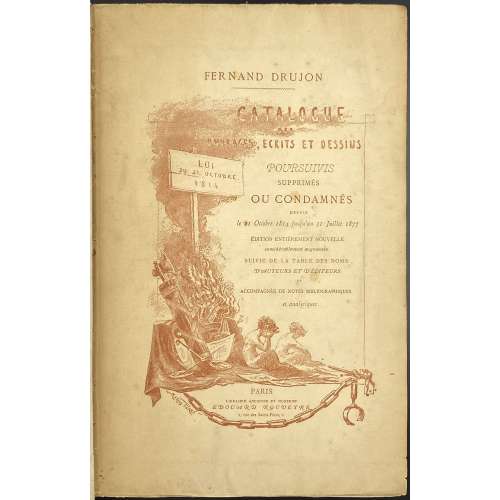 Title page: CATALOGUE | DES | OUVRAGES, ÉCRITS | ET DESSINS | DE TOUTE NATURE | POURSUIVIS, SUPPRIMÉS OU CONDAMNÉS | DEPUIS LE 21 OCTOBRE 1814 JUSQU'AU 31 JUILLET 1877 | Edition entièrement nouvelle, considérablement augmentée | SUIVIE DE LA TABLE DES NOMS D’AUTEURS ET D’ÉDITEURS | ET ACCOMPAGNÉE DE NOTES BIBLIOGRAPHIQUES ET ANALYTIQUES | PAR | FERNAND DRUJON | {publisher’s device} | PARIS | LIBRAIRIE ANCIENNE ET MODERNE | ÉDOUARD ROUVEYRE | 1, RUE DES SAINTS-PÈRES, 1 | 1879 || Pagination: [2] [i-v] vi-xxxvii [xxxviii blank] [1] 2-430 [2] 1-16, total number of pages 2+38+430+2+16=488. Collation: 8vo; π4 i-ii8 1-258 26-294 ω8, total number of leaves 4+(2x8)+(25x8)+(4x4)+8=244; 2 binder’s blank leaves before the front wrapper, 2 blanks after the wrapper, blank / avis important, h.t. with gift inscription from publisher to Anger / limitation, t.p. / blank, [text], 17 leaves of advert., 2 blanks before back wrapper, 1 binder’s blank after. Binding: 28.3 x 19 cm, tree-quarter beige buckram over marbled boards, spine: brown leather label with gilt double fillet top and bottom, gilt lettering, stamped in gilt with a lily and a year of publishing, gilt double-fillet to tail; publisher’s wrappers bound in. Bookplate with motto “AGE DICANT” to front pastedown. Gift inscription: "À mon ami Anger | Hommage de me bien dévoué | Édouard Rouveyre". Possibly Pierre Anger (1854-19..).Contributors: Drujon, Fernand (French, 1845 – 1912) Rouveyre, Édouard (French, 1849 – 1930)Edition: 1st edition, this copy is from an unnumbered print run. Despite the note "Edition entièrement nouvelle, considérablement augmentée" this is obviously the 1st edition.
Title page: CATALOGUE | DES | OUVRAGES, ÉCRITS | ET DESSINS | DE TOUTE NATURE | POURSUIVIS, SUPPRIMÉS OU CONDAMNÉS | DEPUIS LE 21 OCTOBRE 1814 JUSQU'AU 31 JUILLET 1877 | Edition entièrement nouvelle, considérablement augmentée | SUIVIE DE LA TABLE DES NOMS D’AUTEURS ET D’ÉDITEURS | ET ACCOMPAGNÉE DE NOTES BIBLIOGRAPHIQUES ET ANALYTIQUES | PAR | FERNAND DRUJON | {publisher’s device} | PARIS | LIBRAIRIE ANCIENNE ET MODERNE | ÉDOUARD ROUVEYRE | 1, RUE DES SAINTS-PÈRES, 1 | 1879 || Pagination: [2] [i-v] vi-xxxvii [xxxviii blank] [1] 2-430 [2] 1-16, total number of pages 2+38+430+2+16=488. Collation: 8vo; π4 i-ii8 1-258 26-294 ω8, total number of leaves 4+(2x8)+(25x8)+(4x4)+8=244; 2 binder’s blank leaves before the front wrapper, 2 blanks after the wrapper, blank / avis important, h.t. with gift inscription from publisher to Anger / limitation, t.p. / blank, [text], 17 leaves of advert., 2 blanks before back wrapper, 1 binder’s blank after. Binding: 28.3 x 19 cm, tree-quarter beige buckram over marbled boards, spine: brown leather label with gilt double fillet top and bottom, gilt lettering, stamped in gilt with a lily and a year of publishing, gilt double-fillet to tail; publisher’s wrappers bound in. Bookplate with motto “AGE DICANT” to front pastedown. Gift inscription: "À mon ami Anger | Hommage de me bien dévoué | Édouard Rouveyre". Possibly Pierre Anger (1854-19..).Contributors: Drujon, Fernand (French, 1845 – 1912) Rouveyre, Édouard (French, 1849 – 1930)Edition: 1st edition, this copy is from an unnumbered print run. Despite the note "Edition entièrement nouvelle, considérablement augmentée" this is obviously the 1st edition. -

Lithography on paper by Charles Fichot (French, 1817 – 1903), published in a supplement to the Illustrated London News of July 6, 1867.
The construction on the foreground is the International Exposition of 1867 (Exposition universelle d'art et d'industrie de 1867). Dimensions: Sheet: 130 x 58 cm; Image: 118 x 43 cm. -
 Title: Ninth lunar month [菊月] (Kikuzuki no zu); Series: Fashionable Twelve Months (Imayo juni-kagetsu). Another version of translation: Modern Beauties of Twelve Months. Artist: Utagawa Toyokuni I [歌川豊国] (1769–1825). Pubisher: Ibaya Senzaburō [伊場屋仙三郎] (Japanese, 1815 – 1869), seal: Dansendō [伊場仙]. Signed: Toyokuni ga and sealed with toshidama. Date-kiwame seal: Ushi (ox), Bunsei 5 (1822). Size: double-sheet uncut fan print ( aiban uchiwa-e), 219 x 295 mm.
Title: Ninth lunar month [菊月] (Kikuzuki no zu); Series: Fashionable Twelve Months (Imayo juni-kagetsu). Another version of translation: Modern Beauties of Twelve Months. Artist: Utagawa Toyokuni I [歌川豊国] (1769–1825). Pubisher: Ibaya Senzaburō [伊場屋仙三郎] (Japanese, 1815 – 1869), seal: Dansendō [伊場仙]. Signed: Toyokuni ga and sealed with toshidama. Date-kiwame seal: Ushi (ox), Bunsei 5 (1822). Size: double-sheet uncut fan print ( aiban uchiwa-e), 219 x 295 mm.

-
 Artist: Utagawa Kuniyoshi [歌川 國芳] (Japanese, 1798 – 1861). Publisher: Ibaya Senzaburō [伊場屋仙三郎] (Japanese, c. 1815 – 1869). Date-aratame seal: 1827 (Bunsei 10). Inscription: Ohan [おはん], Chōemon [長右衛門] | Dainingyō [大人形] | Yoshida Senshi [吉田千四)] | unclear (work in progress). Sam. L. Leiter describes the play in his Kabuki Encyclopedia (1979) p. 183, and Japanese traditional theatre (2014), p. 252 as "Love Suicide of Ohan and Choemon at the Katsura River" (Katsuragawa Renri no Shigarami) [桂川連理柵], a two-act play by Suga Sensuke [菅専助] (ca. 1728 – 1791) written in 1776 for the puppet theatre jūruri and adopted for Osaka kabuki in 1777. Yoshida Senshi, a.k.a. Yoshida Bunzaburo III was a Japanese puppeteer of a Yoshida lineage. The line was established by Yoshida Bunzaburō I [吉田文三郎] (Japanese, fl. 1717 – 1760), who was one of the greatest in the history of Bunraku [人形浄瑠璃] (ningyō jōruri) and who around 1734 introduced the three-man puppet manipulation system. A portrait of Yoshida Senshi, who died in 1829, can be found in the Kunisada's triptych at Jordan Schnitzer Museum of Art, ID Number 2016:37.2.).
Artist: Utagawa Kuniyoshi [歌川 國芳] (Japanese, 1798 – 1861). Publisher: Ibaya Senzaburō [伊場屋仙三郎] (Japanese, c. 1815 – 1869). Date-aratame seal: 1827 (Bunsei 10). Inscription: Ohan [おはん], Chōemon [長右衛門] | Dainingyō [大人形] | Yoshida Senshi [吉田千四)] | unclear (work in progress). Sam. L. Leiter describes the play in his Kabuki Encyclopedia (1979) p. 183, and Japanese traditional theatre (2014), p. 252 as "Love Suicide of Ohan and Choemon at the Katsura River" (Katsuragawa Renri no Shigarami) [桂川連理柵], a two-act play by Suga Sensuke [菅専助] (ca. 1728 – 1791) written in 1776 for the puppet theatre jūruri and adopted for Osaka kabuki in 1777. Yoshida Senshi, a.k.a. Yoshida Bunzaburo III was a Japanese puppeteer of a Yoshida lineage. The line was established by Yoshida Bunzaburō I [吉田文三郎] (Japanese, fl. 1717 – 1760), who was one of the greatest in the history of Bunraku [人形浄瑠璃] (ningyō jōruri) and who around 1734 introduced the three-man puppet manipulation system. A portrait of Yoshida Senshi, who died in 1829, can be found in the Kunisada's triptych at Jordan Schnitzer Museum of Art, ID Number 2016:37.2.). The design on our fan print looks very much like the one of Toyokuni I at MFA (Houston): OBJECT NUMBER 2006.378. "Seki Sanjuro as Obiya Choemon and Ichikawa Denzo as Ohan of the Shinonoya from the Kabuki Drama Katsuragawa renri no shigarami (Love Suicide of Ohan and Choemon at the Katsura River)", according to MFA-H published by someone Tsuruya in c. 1810 (though the publisher's seal is Suzuki Ihei [鈴木伊兵衛] (seal name Suzui [鈴伊]), Marks 01-028 | 502; the censor's seal is gyōji, date 1811-14).
The design on our fan print looks very much like the one of Toyokuni I at MFA (Houston): OBJECT NUMBER 2006.378. "Seki Sanjuro as Obiya Choemon and Ichikawa Denzo as Ohan of the Shinonoya from the Kabuki Drama Katsuragawa renri no shigarami (Love Suicide of Ohan and Choemon at the Katsura River)", according to MFA-H published by someone Tsuruya in c. 1810 (though the publisher's seal is Suzuki Ihei [鈴木伊兵衛] (seal name Suzui [鈴伊]), Marks 01-028 | 502; the censor's seal is gyōji, date 1811-14).
 Interestingly enough, the description provided by Kuniyoshi Project is this "Actors: Onoe Kikugorô III as Shinanoya Ohan (おはん, female) and Ichikawa Ebizô V as Obiya Choemon (長右衛門, male). Play: Go chumon shusu no Obiya (御注文繻子帯屋). Date: 3rd month of 1840. Theater: Kawarasaki. Publisher: Iba-ya Sensaburô".
The play Go chumon shusu no Obiya was indeed staged at Kawarazaki theatre in 1840 (Tenpō 11), 3rd month; Ichikawa Ebizō V was indeed playing Obiya Choemon but Onoe Kikugorō III had the role of Kataoka Kōzaemon, not of Ohan, as can be seen on Kunisada's diptych at MFA (Boston): ACCESSION NUMBER 11.40671a-b.
Interestingly enough, the description provided by Kuniyoshi Project is this "Actors: Onoe Kikugorô III as Shinanoya Ohan (おはん, female) and Ichikawa Ebizô V as Obiya Choemon (長右衛門, male). Play: Go chumon shusu no Obiya (御注文繻子帯屋). Date: 3rd month of 1840. Theater: Kawarasaki. Publisher: Iba-ya Sensaburô".
The play Go chumon shusu no Obiya was indeed staged at Kawarazaki theatre in 1840 (Tenpō 11), 3rd month; Ichikawa Ebizō V was indeed playing Obiya Choemon but Onoe Kikugorō III had the role of Kataoka Kōzaemon, not of Ohan, as can be seen on Kunisada's diptych at MFA (Boston): ACCESSION NUMBER 11.40671a-b.

Actors Ichikawa Ebizô V as Obiya Chôemon (R) and Onoe Kikugorô III as Kataoka Kôzaemon (L)
-
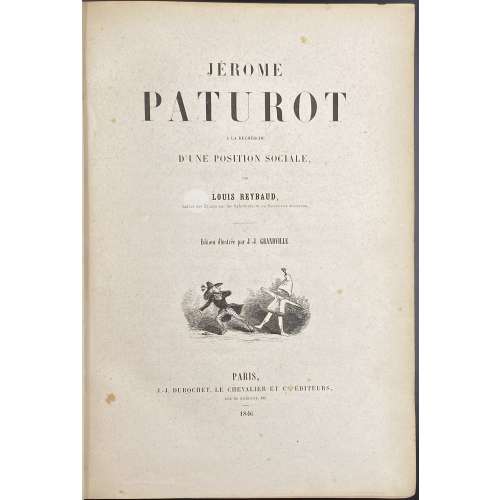 4to volume, ‘cartonnage percaline romantique’, 27.5 x 19.5 cm, green cloth with gilt fillet border and fictional coat of arms to front, border and fleuron to back, gilt and embossed vignette to spine, yellow endpapers, all edges gilt, 32 plates, incl. frontispiece, with tissue guards, and numerous in-text woodcuts after J.-J. Grandville by various engravers, mostly by Best, Leloir, Hotelin et Régnier group. Page 102 is numbered correctly. Title-page: JÉROME | PATUROT | A LA RECHERCHE | D'UNE POSITION SOCIALE | PAR | LOUIS REYBAUD, | Auteur des Études sur les Reformateurs ou Socialistes modernes. | — | Édition illustrée par J.-J. Grandville. | {vignette} | PARIS, | J.-J. DUBOCHET, LE CHEVALIER ET Cie, ÉDITEURS, | RUE DE RICHELIEU, 60. | – | 1846 || Collation: π4 1-574 582; total 234 leaves plus 32 wood-engraved plates extraneous to collation. Pagination: [8] [1] 2-460; total 468 pages, ils. Catalogue raisonné: L. Carteret 516; Ray 197 (pp. 277-8); Brivois: 350-1. Contributors: Louis Reybaud [Jérôme Paturot] (French, 1799 – 1879) – author. J.-J. Grandville [Isidore-Adolphe Gèrard] (French, 1803 – 1847) – artist. Schneider et Legrand (Paris) – printer. J.-J. Dubochet, Le Chevalier et Cie – publsiher. Engravers: Lucjan Stypulkowski (Polish, 1806 – 1849) Best, Leloir, Hotelin et Régnier Jean Baptiste Best (French, 1808 – 1879) or Adolphe Best (French, 1808 – 1860) Isidore Leloir (French, 1806 – 1851) Laurent Éloi Hotelin (French, 1821 – 1894) Eugène Laurent Isidore Régnier (?)
4to volume, ‘cartonnage percaline romantique’, 27.5 x 19.5 cm, green cloth with gilt fillet border and fictional coat of arms to front, border and fleuron to back, gilt and embossed vignette to spine, yellow endpapers, all edges gilt, 32 plates, incl. frontispiece, with tissue guards, and numerous in-text woodcuts after J.-J. Grandville by various engravers, mostly by Best, Leloir, Hotelin et Régnier group. Page 102 is numbered correctly. Title-page: JÉROME | PATUROT | A LA RECHERCHE | D'UNE POSITION SOCIALE | PAR | LOUIS REYBAUD, | Auteur des Études sur les Reformateurs ou Socialistes modernes. | — | Édition illustrée par J.-J. Grandville. | {vignette} | PARIS, | J.-J. DUBOCHET, LE CHEVALIER ET Cie, ÉDITEURS, | RUE DE RICHELIEU, 60. | – | 1846 || Collation: π4 1-574 582; total 234 leaves plus 32 wood-engraved plates extraneous to collation. Pagination: [8] [1] 2-460; total 468 pages, ils. Catalogue raisonné: L. Carteret 516; Ray 197 (pp. 277-8); Brivois: 350-1. Contributors: Louis Reybaud [Jérôme Paturot] (French, 1799 – 1879) – author. J.-J. Grandville [Isidore-Adolphe Gèrard] (French, 1803 – 1847) – artist. Schneider et Legrand (Paris) – printer. J.-J. Dubochet, Le Chevalier et Cie – publsiher. Engravers: Lucjan Stypulkowski (Polish, 1806 – 1849) Best, Leloir, Hotelin et Régnier Jean Baptiste Best (French, 1808 – 1879) or Adolphe Best (French, 1808 – 1860) Isidore Leloir (French, 1806 – 1851) Laurent Éloi Hotelin (French, 1821 – 1894) Eugène Laurent Isidore Régnier (?) -
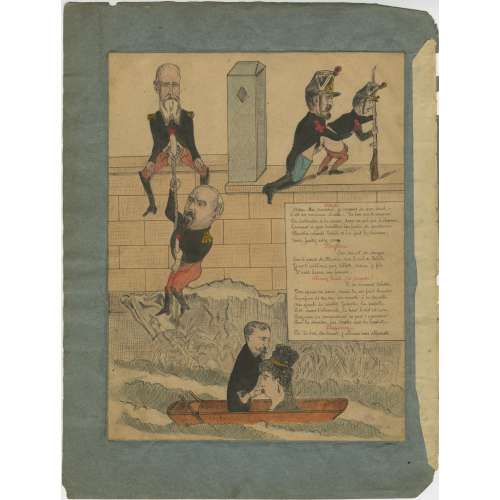 A series of seven political caricatures with indecent content, ink and pigment on paper, bound in a grey-blue folder. Each drawing is pasted to a grey-blue sheet of paper 32 x 24 cm. PLATES: 1) Villette; Bazaine; Alvarez Rull: 250 x 192 mm
A series of seven political caricatures with indecent content, ink and pigment on paper, bound in a grey-blue folder. Each drawing is pasted to a grey-blue sheet of paper 32 x 24 cm. PLATES: 1) Villette; Bazaine; Alvarez Rull: 250 x 192 mm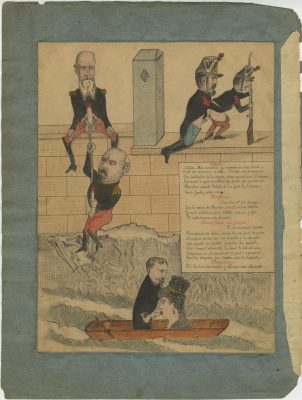
Villette Adieu, cher maréchal, je réponds de mon dard C’est un morceau d’acier… Là bas, sur le rempart, Sa cartouche à la main, dans un cul qui le charme, Lançant à gros bouillons son foutre de gendarme Plantin plante Delille et lui font le Caisson. Bazaine Sur ton vit de dragon Sur le nœud de Plantin, sur le cul de Delille, Je ne t’oublierai pas, Villette, adieu, je file Et je vais baiser ma femme. Alvarez Rull (à Josépha) Il ne saurait tarder, Ton epoux va venir, mais tu me fais bander, Le parfum de ton con me monte à la cervelle, Ma gaule se raidit . Josépha, la nacelle Est dans l’ obscurité, là haut, le ciel est noir, Bazaine en descendant ne peut t’ apercevoir … Pour la dernière fois, torche moi la houlette. Bazaine Eh ! là bas, du canot, j’allume une allumette!
Villette Farewell, dear Marshal, I vouch for my dick. It’s like a steel rod … Over there, on the ramparts, Plantin, his dick in hand, pounds Delisle’s beckoning ass And fills it with his bubbling gendarme’s cum. Bazaine For your dragoon’s dick, For Plantin's prick, for Delisle's ass, I won't forget you, Villette, goodbye, I'm leaving And I'm going to fuck my wife. Alvarez Rull (to Josépha) Hurry up, Your husband is coming, but I got a hard on you, The scent of your cunt penetrates my brain, My rod stiffened. Josépha, the gondola Is in the dark, the sky is black, Bazaine coming down and cannot see you... Give me one last blowjob.Bazaine Hey! Over there, from the canoe, I light a match!
French marshal Achille Bazaine capitulated to Bismarck during the Franco-Prussian war on 27 October 1870. In 1873, he was tried for treason and received a death sentence, later commuted to 20 years' imprisonment. Bazaine was incarcerated in the Fort Royal on Île Sainte-Marguerite, from which he escaped on August 9–10, 1874, with the help of Colonel Villette [Willette], his wife Josefa [Pepita Peña], and her nephew Alvarez Rull. They sailed to Genoa in Italy and from there to London. Plantin and Delisle were prison guards. The story was described in detail during the Trial of Col. Villette and his Accomplices in 1874 and published later in Robert Christophe. La Vie tragique du maréchal Bazaine. — Paris: Vautrain Jacques, 1947.
2) Impératrice Eugénie: 218 x 165 mm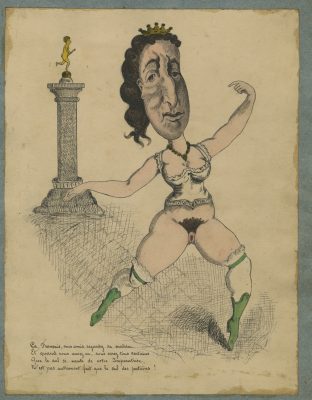
Ça, Français, mes amis, regardez sa matrice, Et quand vous aurez vu, vous serez tous certains Que le cul si vanté de votre Impératrice, N’est pas autrement fait que le cul des putains!
That, French, my friends, look at her cunt, And when you have seen, you will all be certain That the so acclaimed ass of your Empress, Is no different than the ass of whores! 3) Napoléon III: 215 x 168 mm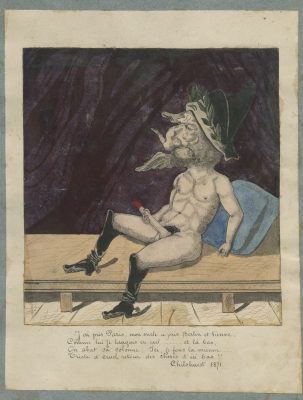
J’ai pris Paris, mon oncle a pris Berlin et Vienne. Comme lui je languis en exil …… et là bas, On abat sa colonne; Ici, je fous la mienne…. Triste et cruel retour des choses d’ici bas!! Chilshurst 1871. [i.e. Chislehurst]
I took Paris, my uncle took Berlin and Vienna. Like him, I, too, languish in exile. His column there was demolished; I’m jerking mine off here…. Cruel and sorrowful deeds!! 4) La confession: 216 x 168 mm (Georges Darboy?)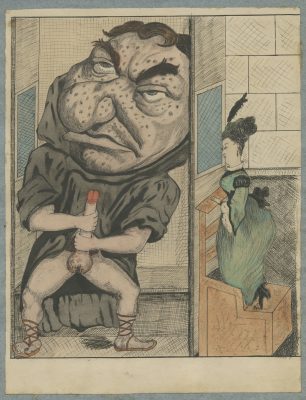 5) Napoléon III et Thérèsa (chanteuse Désirée Emma Valladon): 216 x 176 mm
5) Napoléon III et Thérèsa (chanteuse Désirée Emma Valladon): 216 x 176 mm
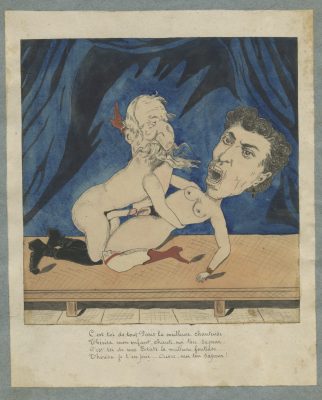
C’est toi de tout Paris la meilleure chanteuse, Thérèsa mon enfant, chante-moi ton sapeur. C’est toi de mes Etats la meilleure fonteuse.. Thérèsa je t’en prie … Ouvre-moi ton sapeur!
You, the best singer in all of Paris, Teresa, my child, sing for me where to insert. You are the best padding in my entire country… Teresa, please... Open your slit for me! 6) Thiers: 219 x 168 mm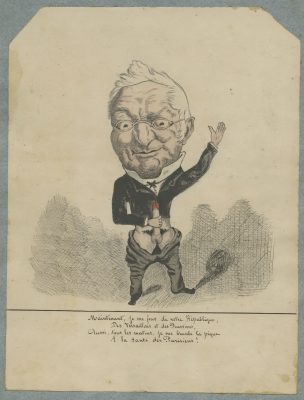
Maintenant, je me fous de votre République, Des Versaillais et des Prussiens, Aussi, tous les matins, je me branle la pique A la santé des Parisiens!
Yes, I don’t care about your Republic now, About Versailles and the Prussians, And every morning I jerk off For the health of Parisians! 7) Émile Ollivier/Rochefort/Jules Favre/Gambetta : 212 x 168 mm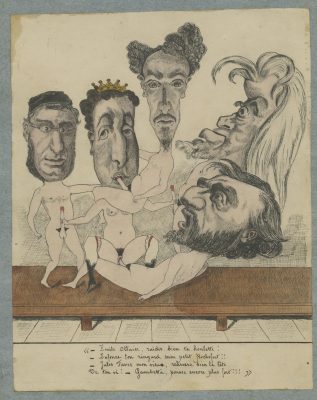
« — Emile Ollivier, raidis bien la houlette! — Enfonce ton ringard mon petit Rochefort!! — Jules Favre mon vieux, redresse bien la tête De ton vi! — Gambetta, pousse encore plus fort!!! »
Emile Ollivier, tighten your dick! - Stick in your poker, my little Rochefort!! - Jules Favre, old man, straighten your dickhead Damn it! – Gambetta, push even harder!!!Characters: Bazaine, François Achille (French, 1811 – 1888) Darboy, Georges (French, 1813 – 1871) Favre, Jules (French, 1809 – 1880) Gambetta, Léon (French, 1838 – 1882) Montijo, Eugénie de (Spanish-French, 1826 – 1920) Napoleon III [Bonaparte, Charles-Louis Napoléon] (French, 1808 – 1873) Ollivier, Émile (French, 1825 – 1913) Peña Azcárate, Josefa [Peña, Pepita] (Mexican-French, 1847 – 1900); Alvarez Rull – nephew of Josefa Peña Azcárate. Rochefort, Henri (French, 1831 – 1913) Thérésa [Valladon, Désirée Emma] (French, 1836 – 1913) Thiers, Adolphe (French, 1797 – 1877)
-
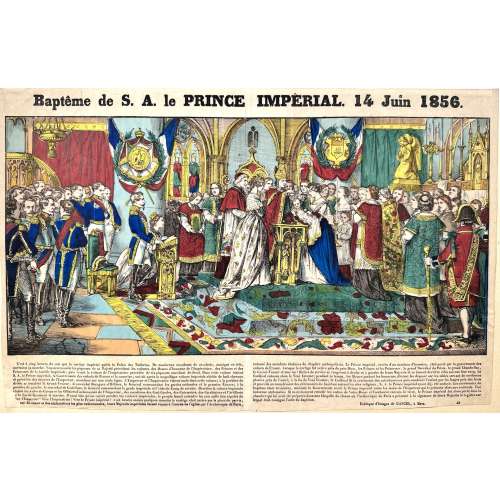 Hand-coloured woodcut on wove paper, 610 x 390 mm; black ink stamp “5207” to reverse, attached to a larger sheet of thick paper with a red ink stamp: “COLLECTION JEAN-CLAUD LACHNITT | REPRODUCTION INTERDIT”. Top: Baptême de S. A. le PRINCE IMPÉRIAL. 14 Juin 1856; image of baptism of Prince-Impérial; two-column text with a small loss in the lower left corner (C'est à cinq heures du soir que le cortège impérial quitta le Palais des Tuileries. De nombreux escadrons de cavalerie, musique en tête ouvraient la marche. ...); bottom under the text: "Fabrique d'Images de GANGEL, à Metz." — "49".
Hand-coloured woodcut on wove paper, 610 x 390 mm; black ink stamp “5207” to reverse, attached to a larger sheet of thick paper with a red ink stamp: “COLLECTION JEAN-CLAUD LACHNITT | REPRODUCTION INTERDIT”. Top: Baptême de S. A. le PRINCE IMPÉRIAL. 14 Juin 1856; image of baptism of Prince-Impérial; two-column text with a small loss in the lower left corner (C'est à cinq heures du soir que le cortège impérial quitta le Palais des Tuileries. De nombreux escadrons de cavalerie, musique en tête ouvraient la marche. ...); bottom under the text: "Fabrique d'Images de GANGEL, à Metz." — "49". -
 Utagawa Kuniyoshi (attributed to). Memorial portrait (Shini-e, death picture) of Nakamura Utaemon IV (a.k.a. Shikan II) as Taira no Kiyomori (1118-81). Date: 1852. Reference: [LIB-1030.2016] Robert Schaap. Heroes & ghosts: Japanese prints by Kuniyoshi, 1797-1861. — Leiden: Hotei Publishing, 1998; p. 165, image 176. [LIB-3316.2024] Chris Uhlenbeck, Jim Dwinger, Josephine Smit. The Riddles of Ukiyo-e: Women and Men in Japanese Prints. — Brussels: Ludion, 2023; pp. 242-3, № 119. Provenance: Herbert Egenolf Collection, Germany. Literature: Suzuki (1992) 317. Trimmed, unsigned.
Utagawa Kuniyoshi (attributed to). Memorial portrait (Shini-e, death picture) of Nakamura Utaemon IV (a.k.a. Shikan II) as Taira no Kiyomori (1118-81). Date: 1852. Reference: [LIB-1030.2016] Robert Schaap. Heroes & ghosts: Japanese prints by Kuniyoshi, 1797-1861. — Leiden: Hotei Publishing, 1998; p. 165, image 176. [LIB-3316.2024] Chris Uhlenbeck, Jim Dwinger, Josephine Smit. The Riddles of Ukiyo-e: Women and Men in Japanese Prints. — Brussels: Ludion, 2023; pp. 242-3, № 119. Provenance: Herbert Egenolf Collection, Germany. Literature: Suzuki (1992) 317. Trimmed, unsigned. -

Bronze tsuba of mokkō form with narrow slightly raised rim carved in kebori with the sea weed and inlaid with a lobster (ebi) made of copper on the face and two sea shells made of shakudo on the back. Lobster's antennae inlaid in gold, and eyes inlaid in shakudo. Ishime-ji treated surface.
Unsigned.
Late Edo period (mid-19th century). Dimensions: 76.3 x 71.1 x 3.7 mm





